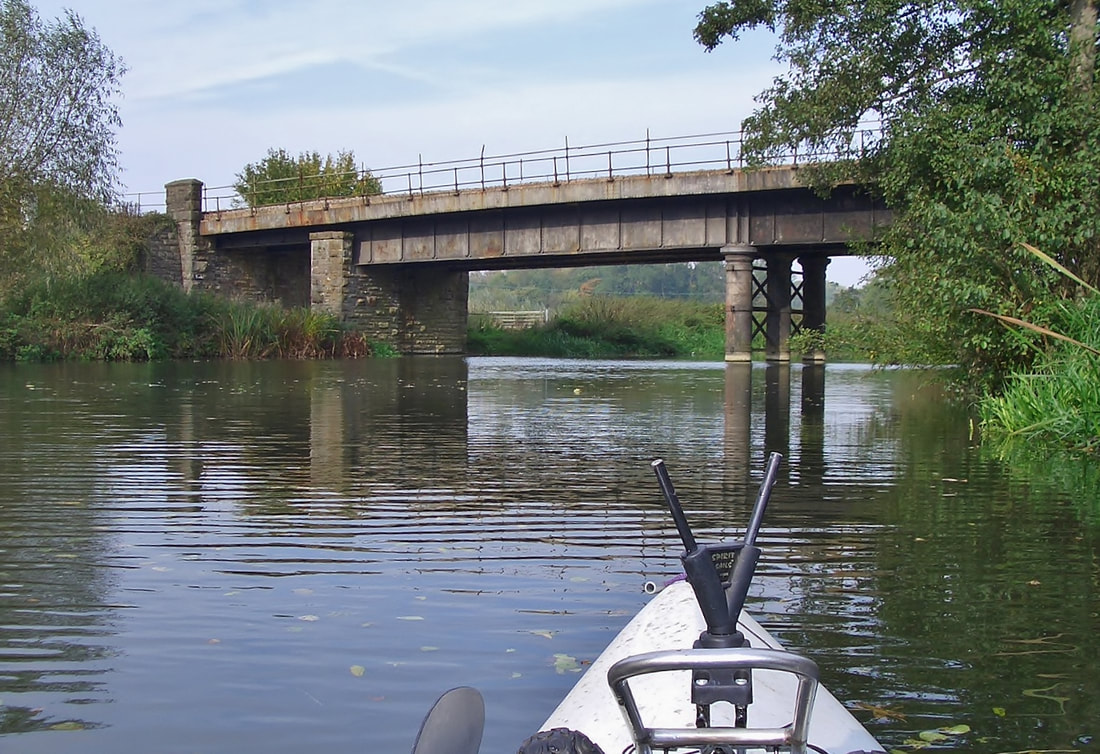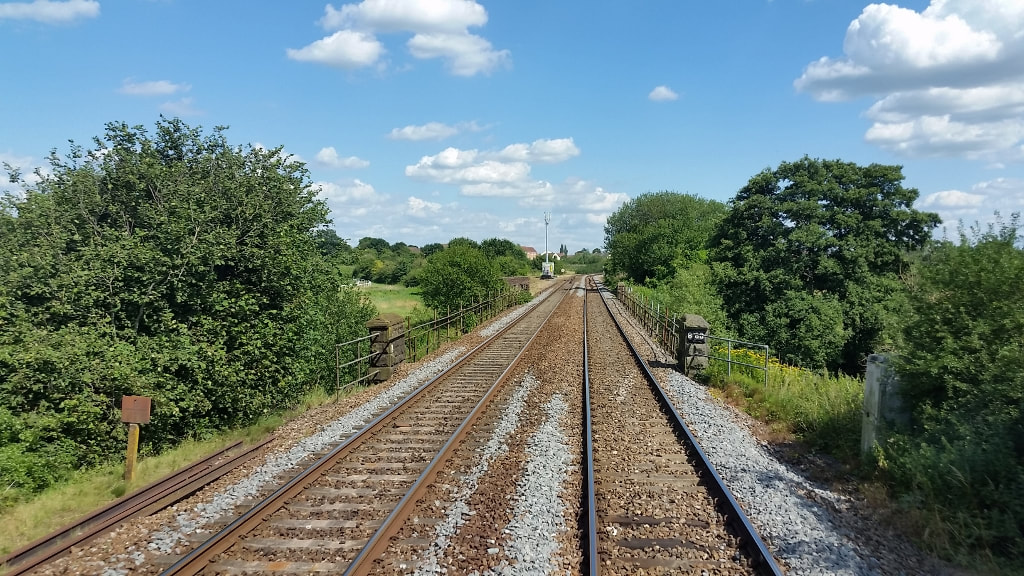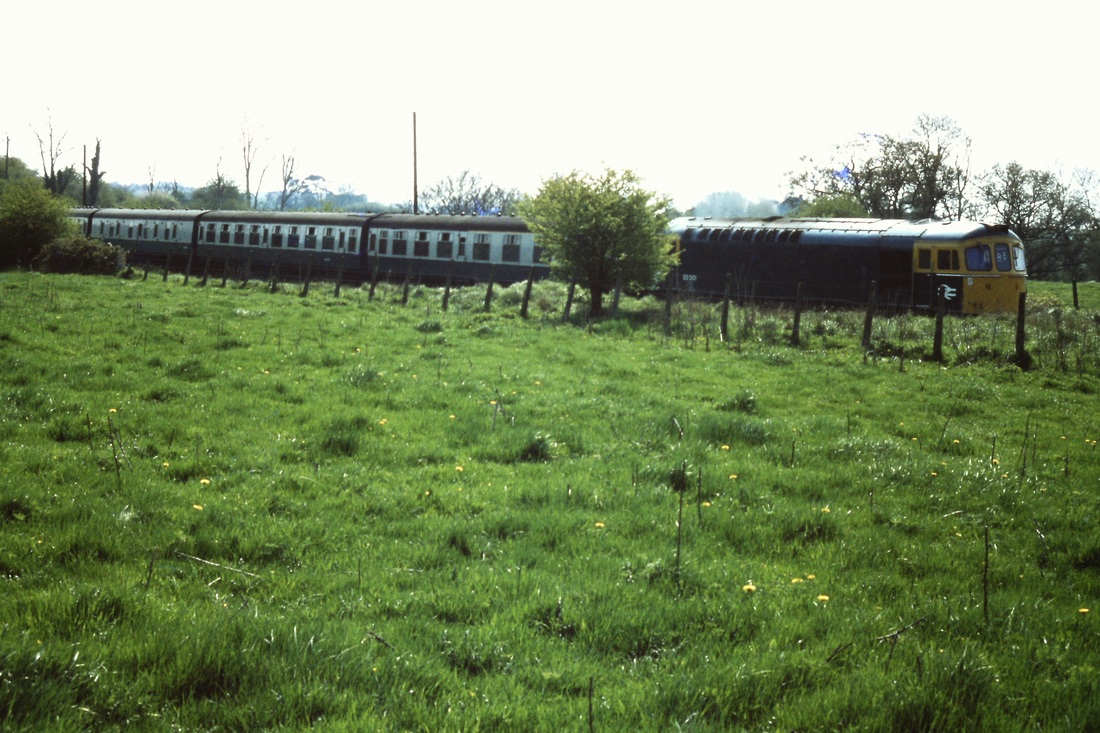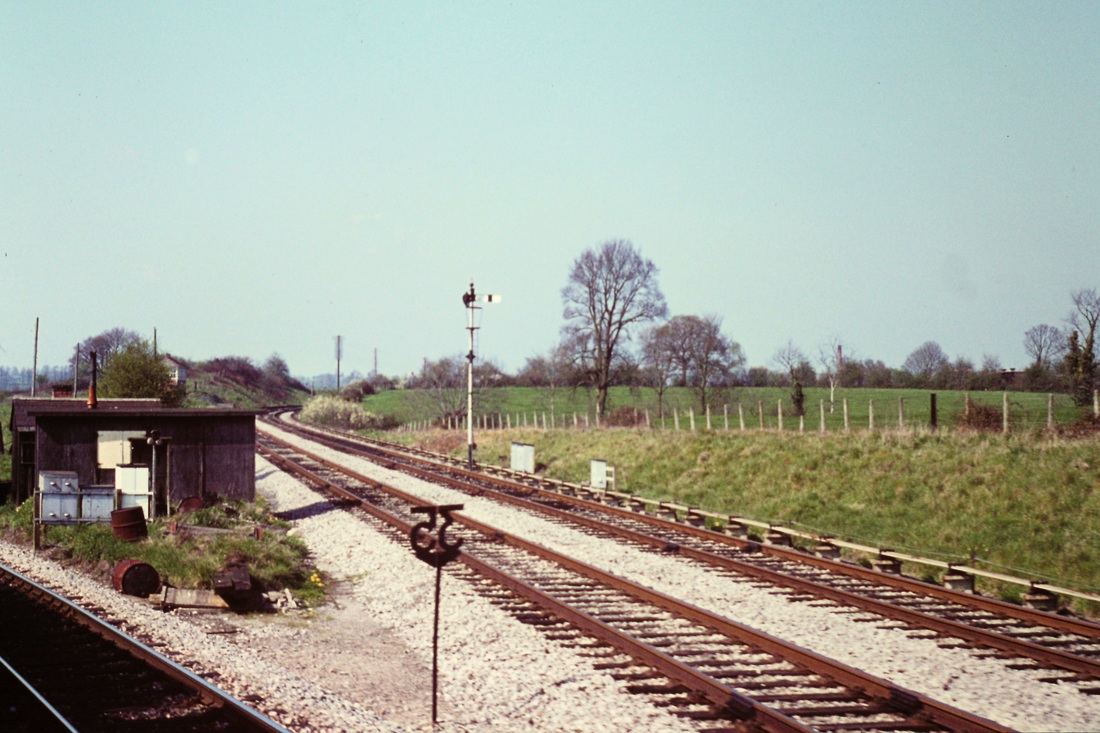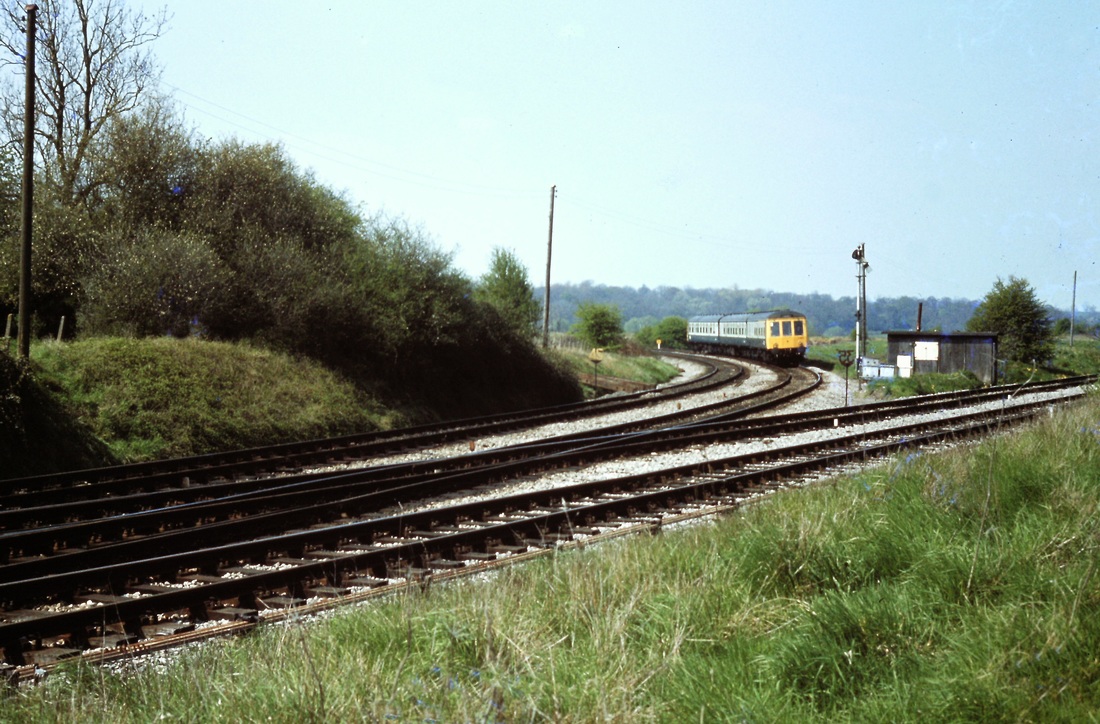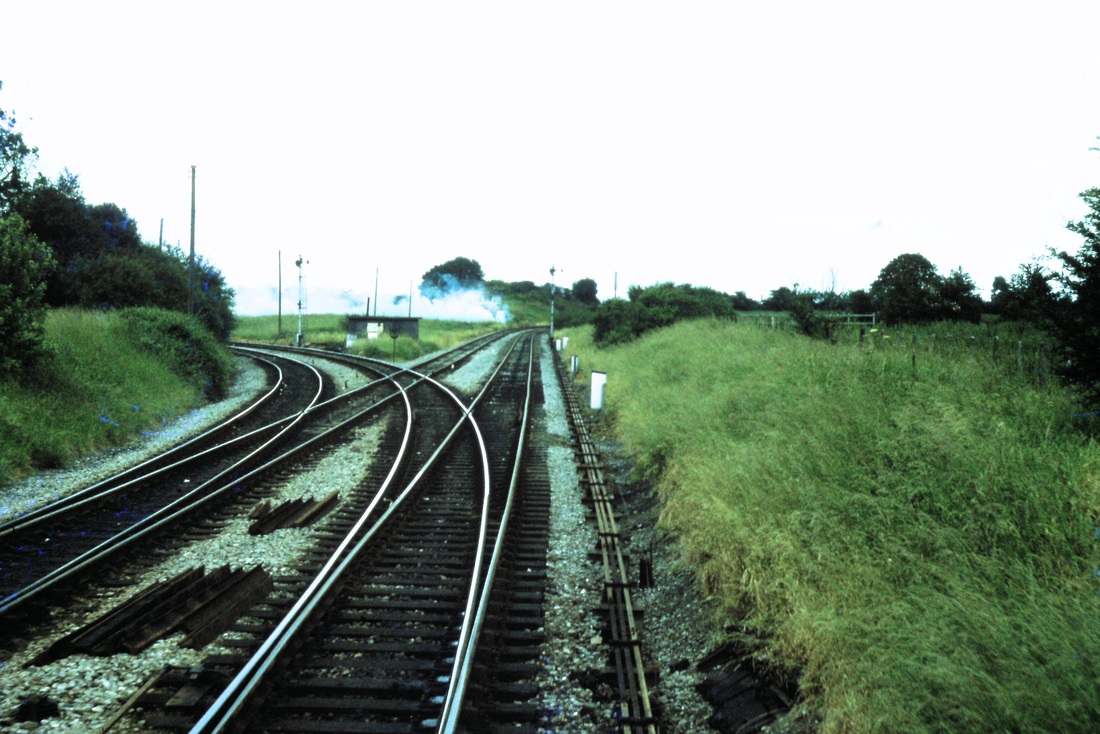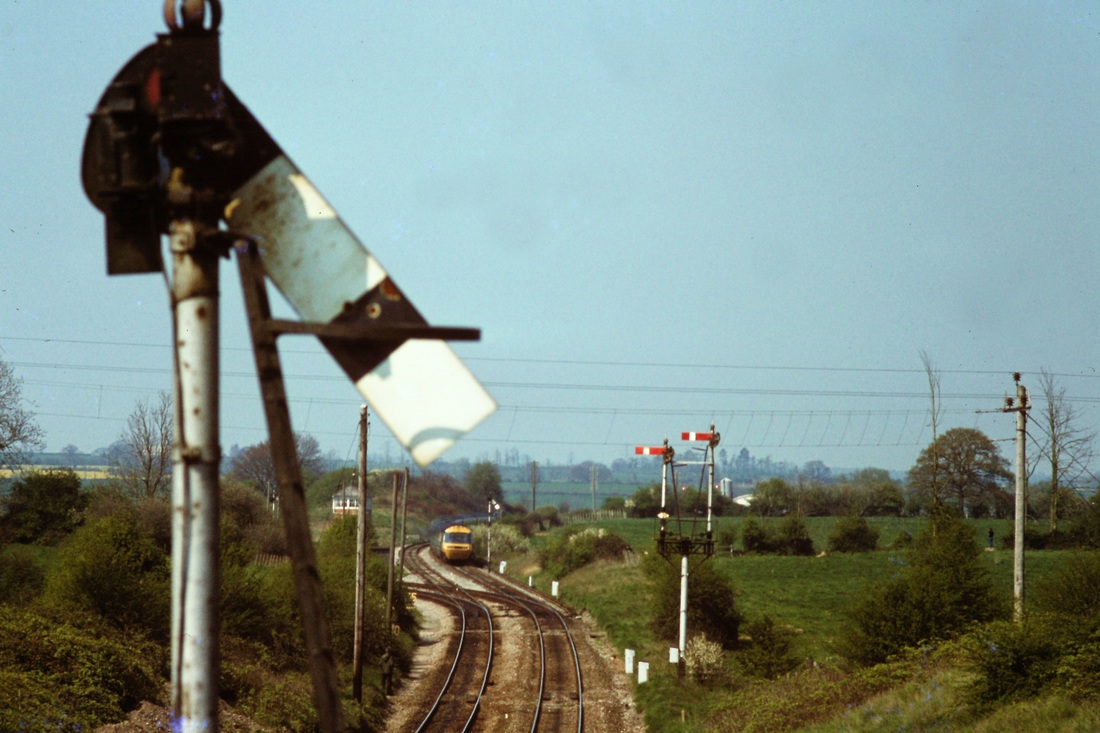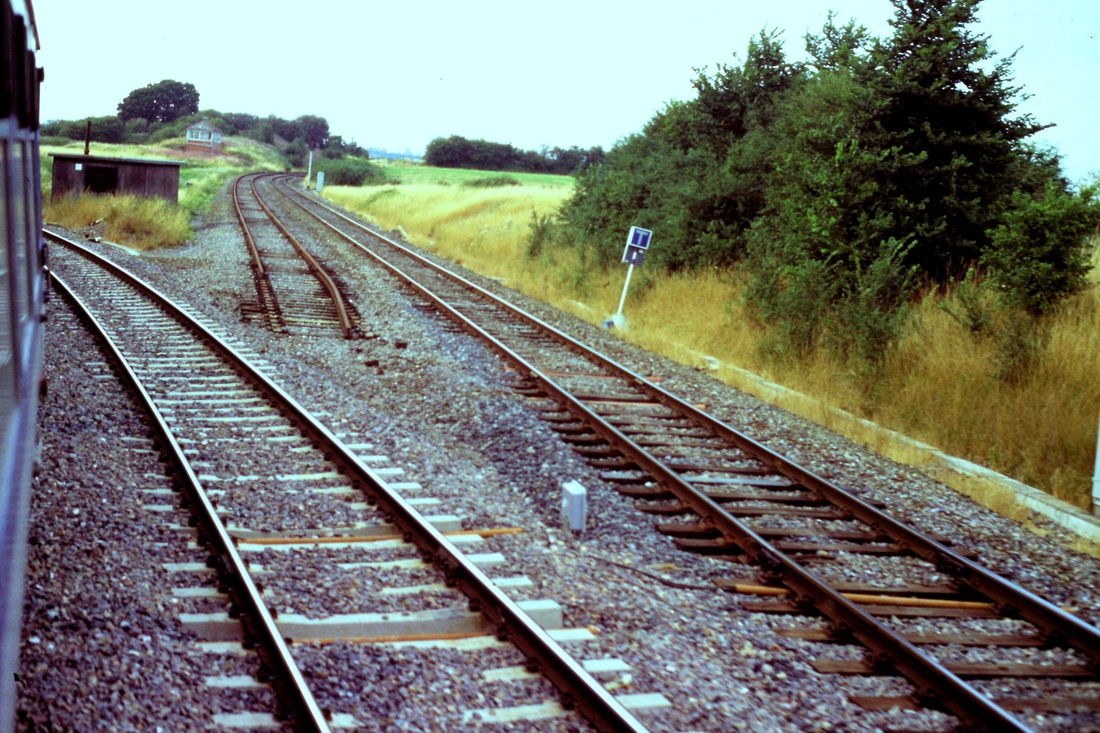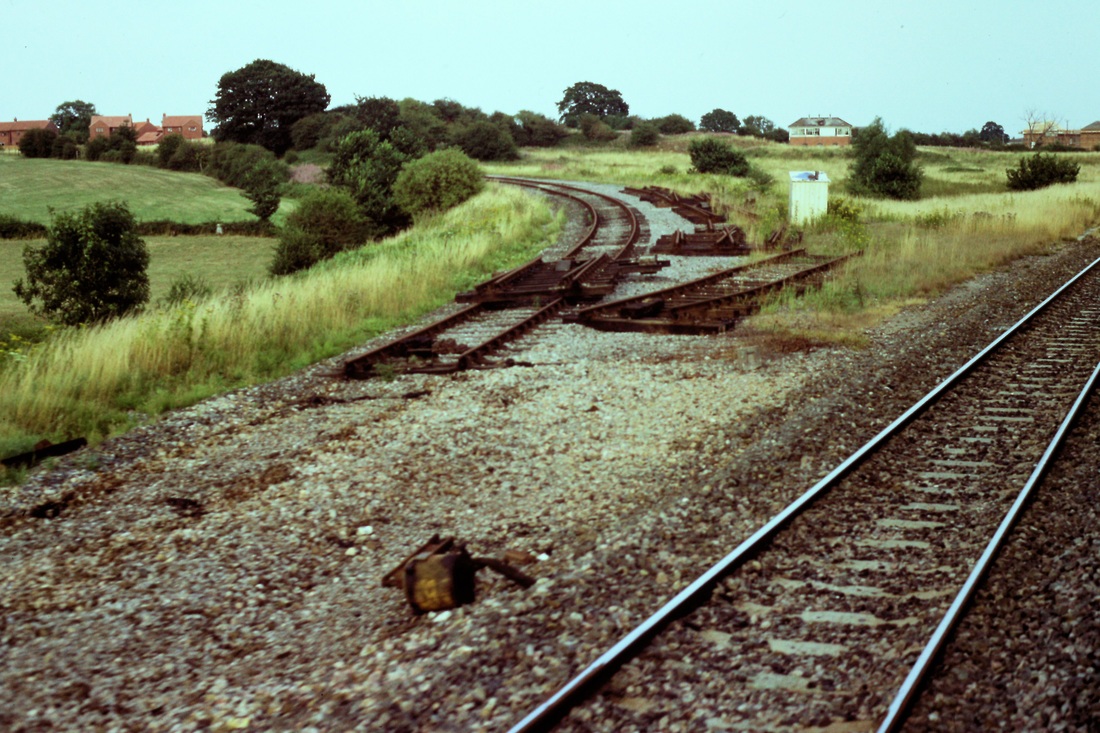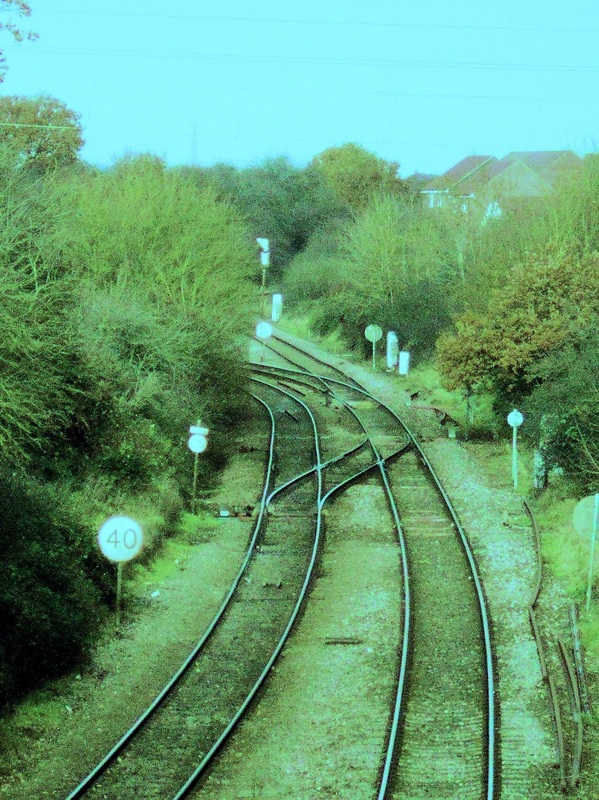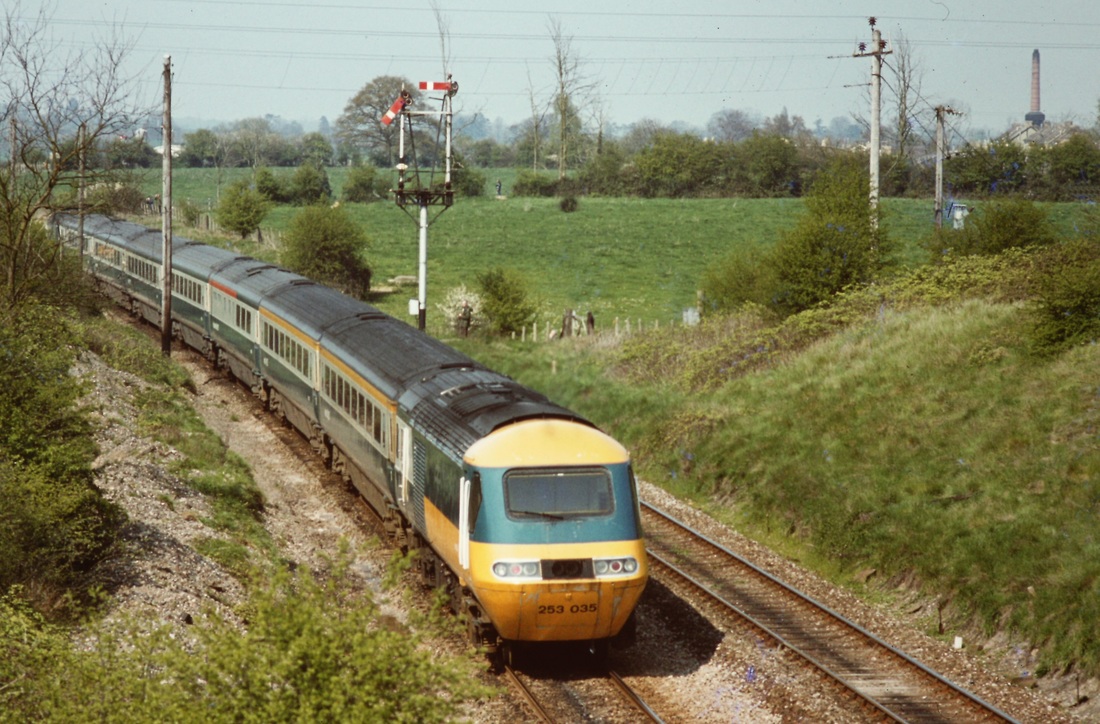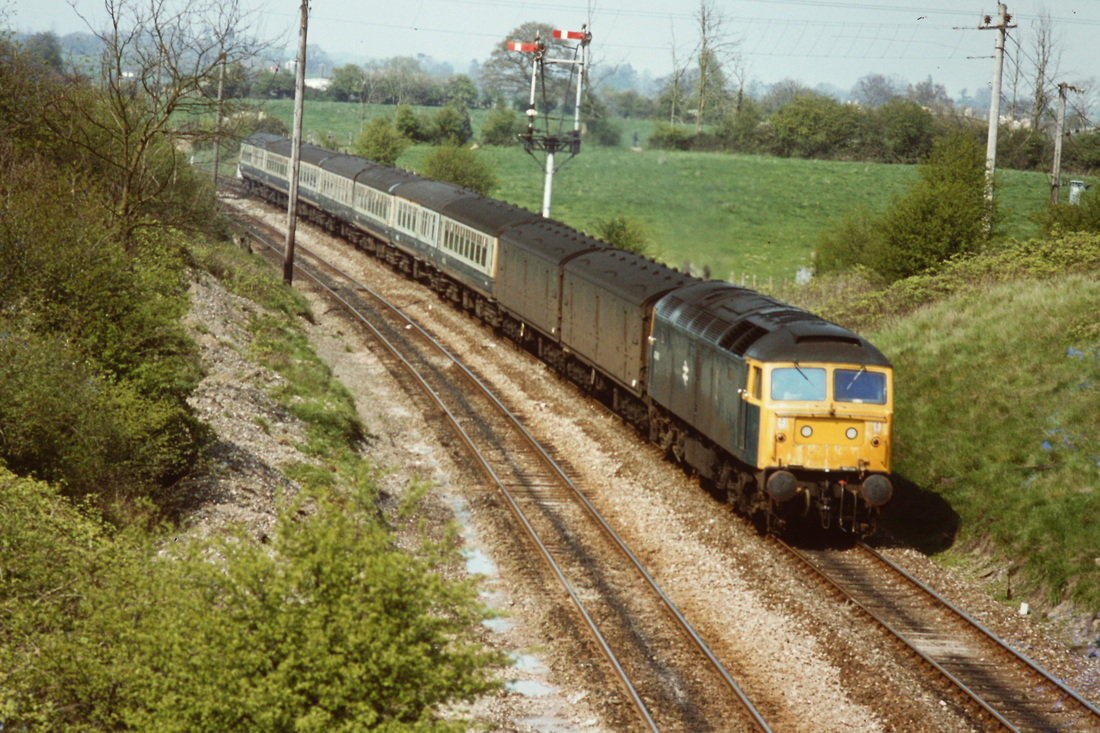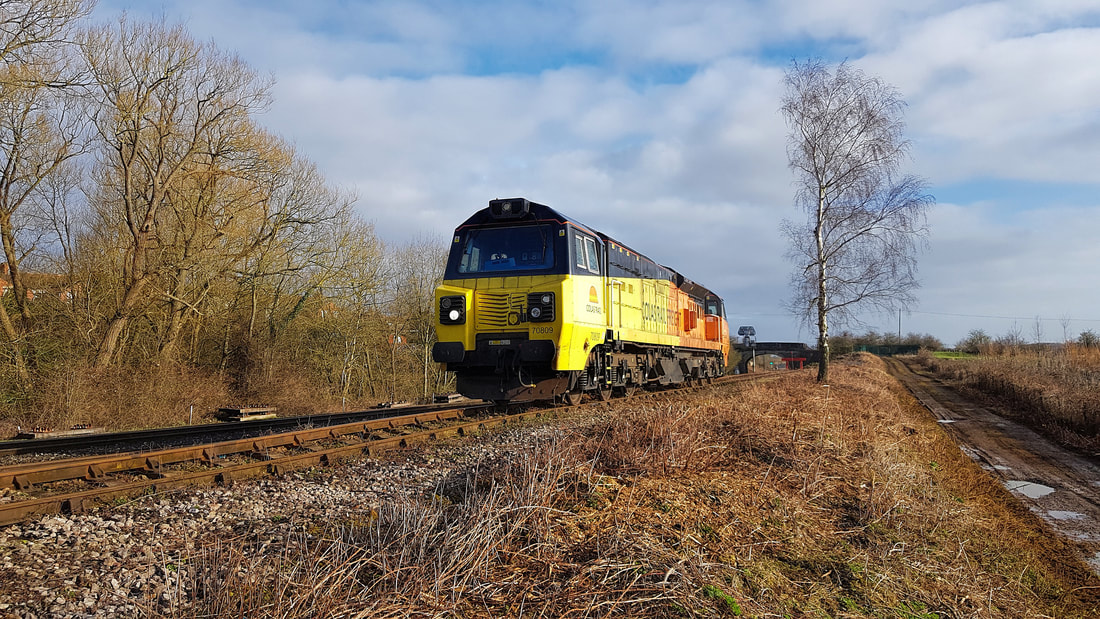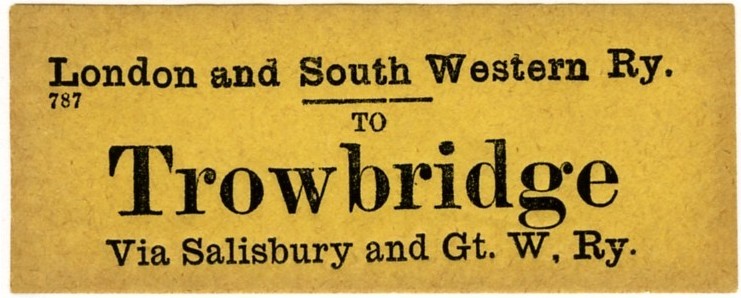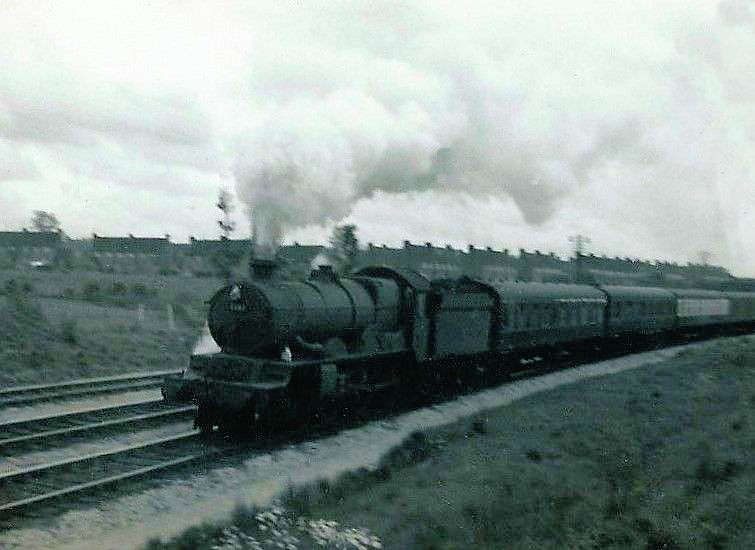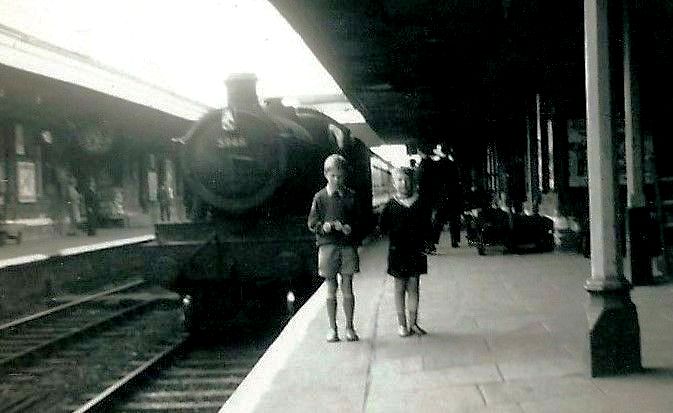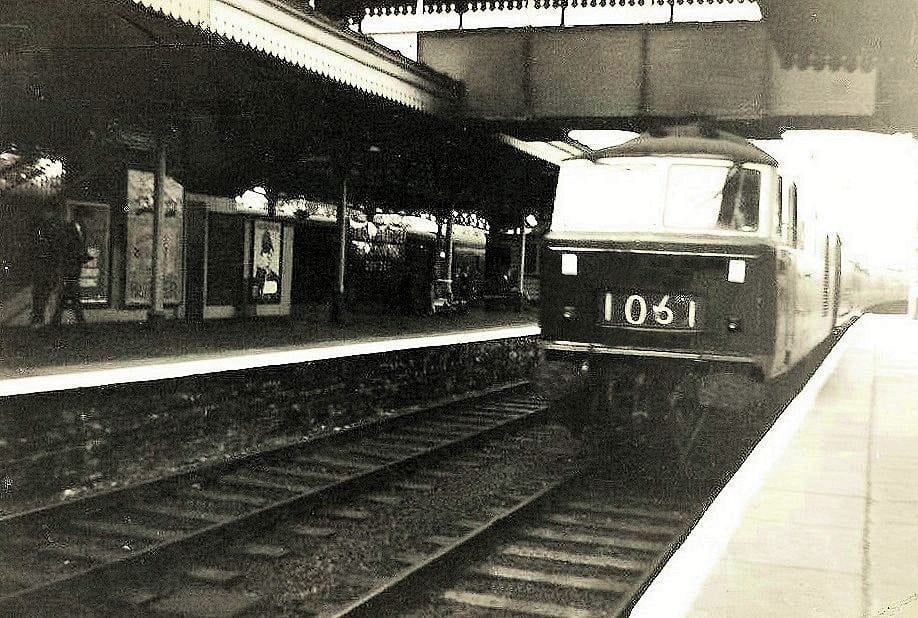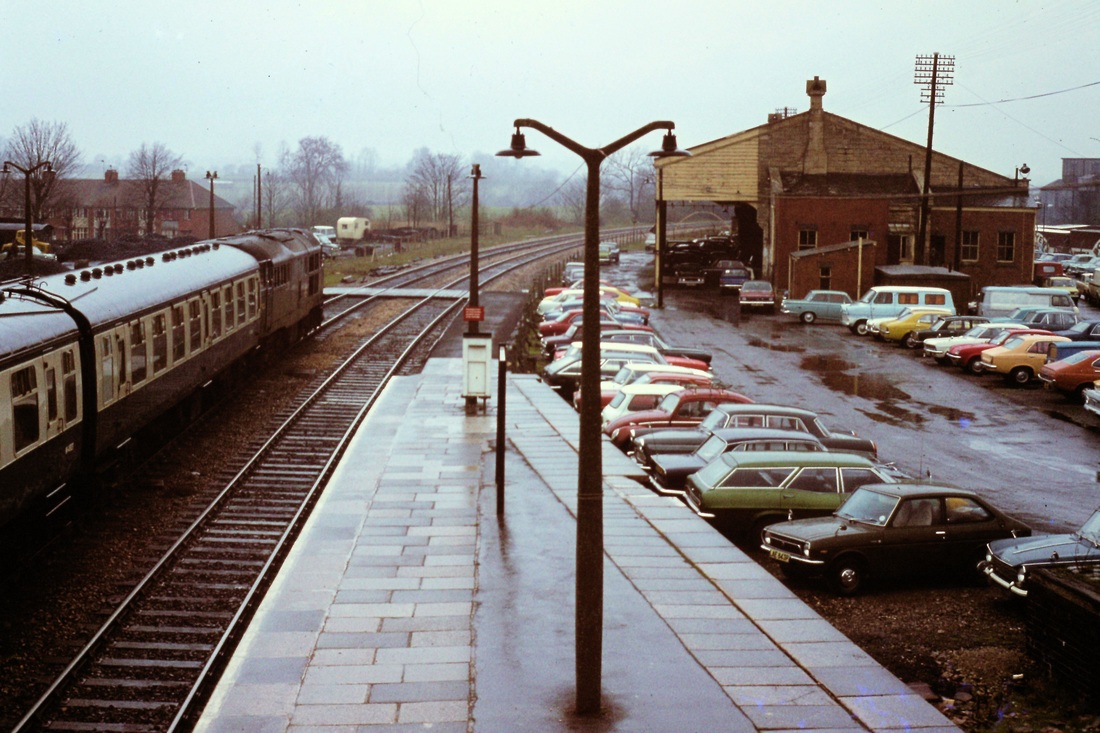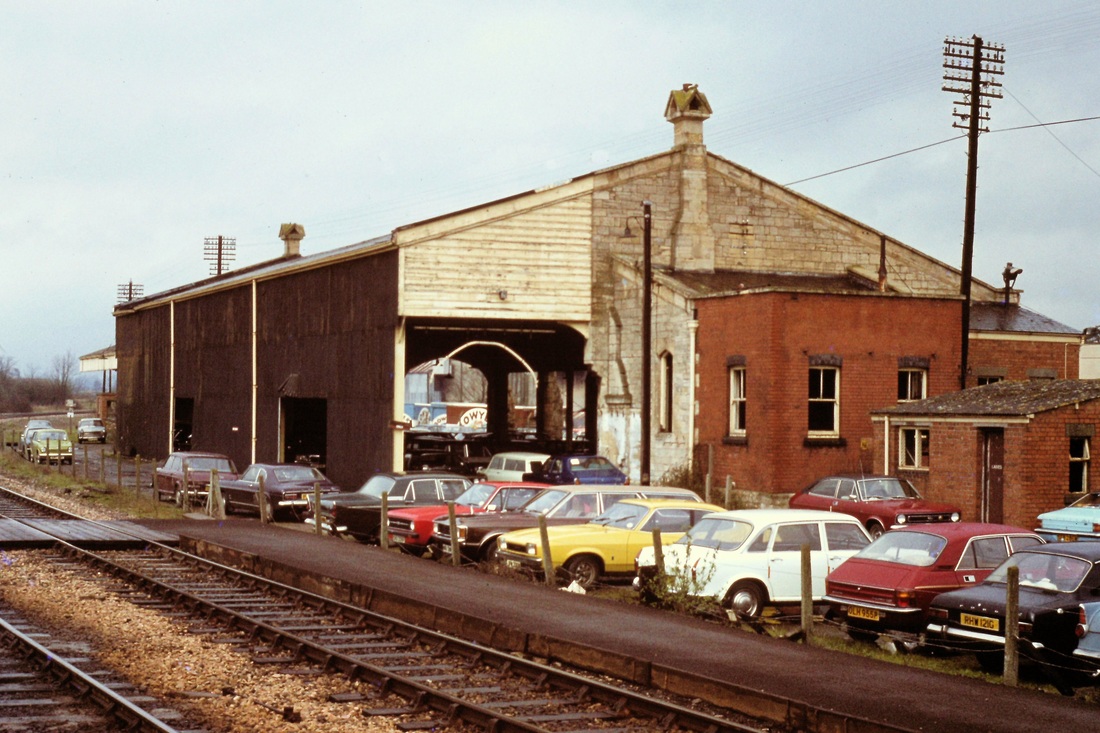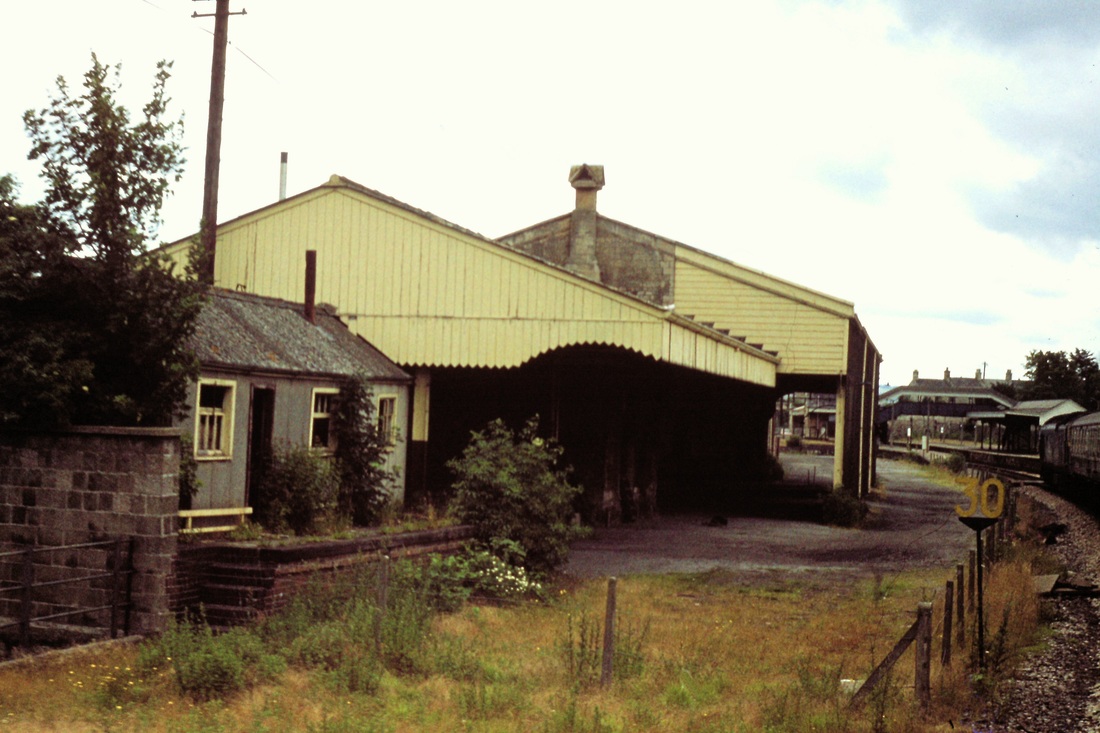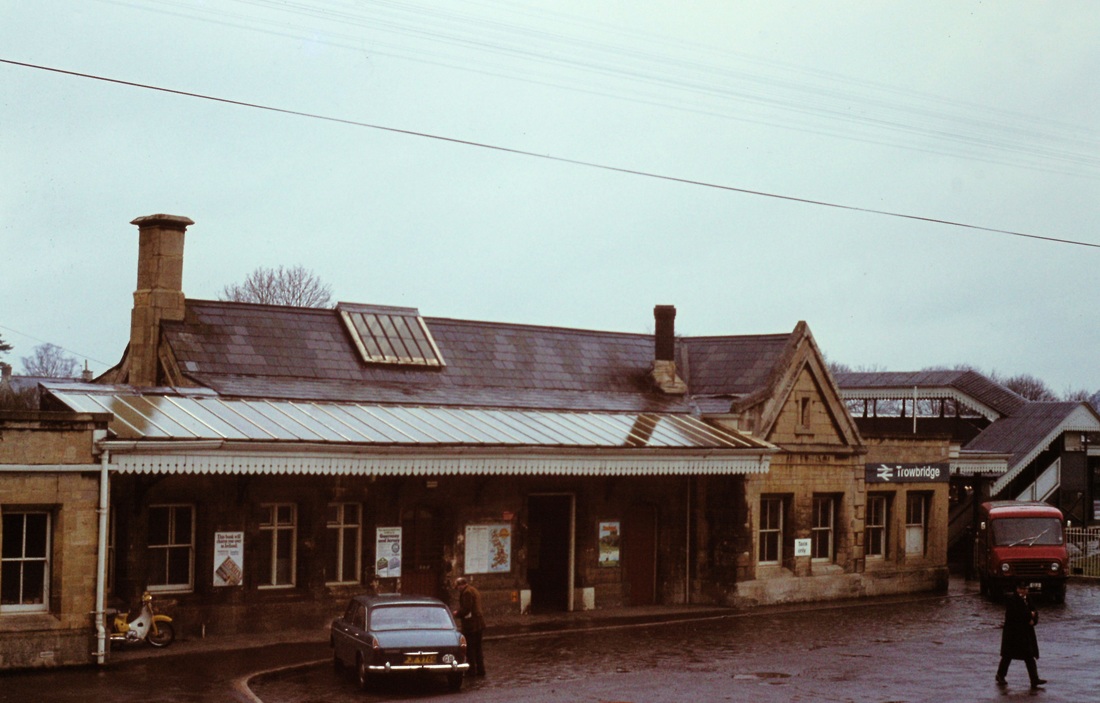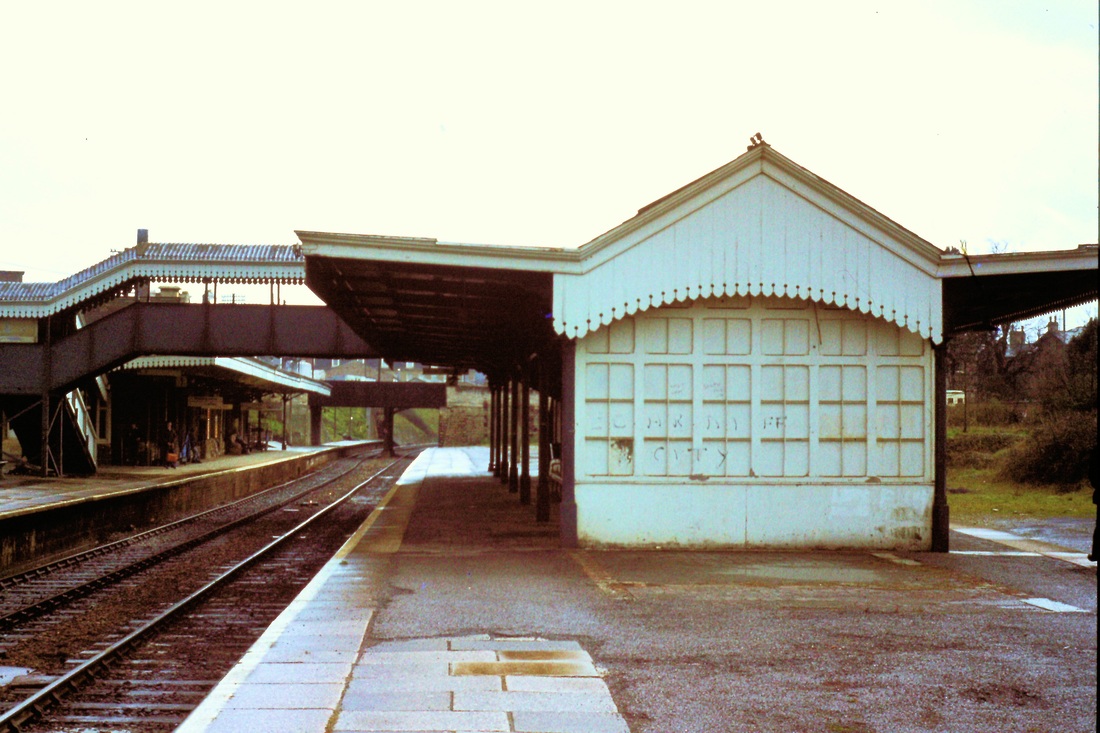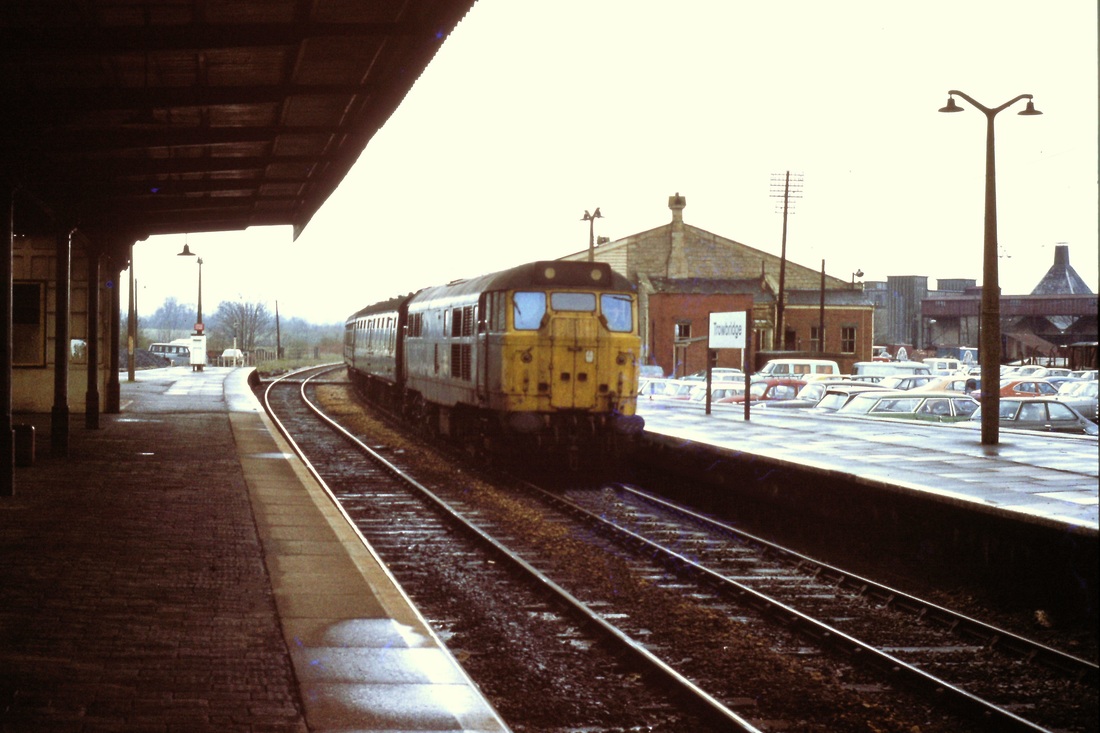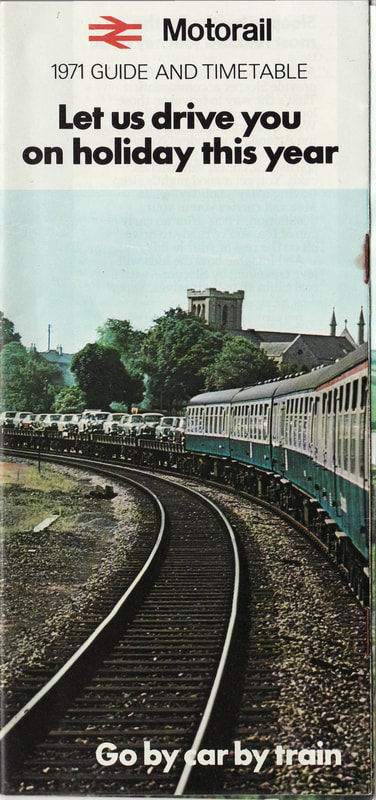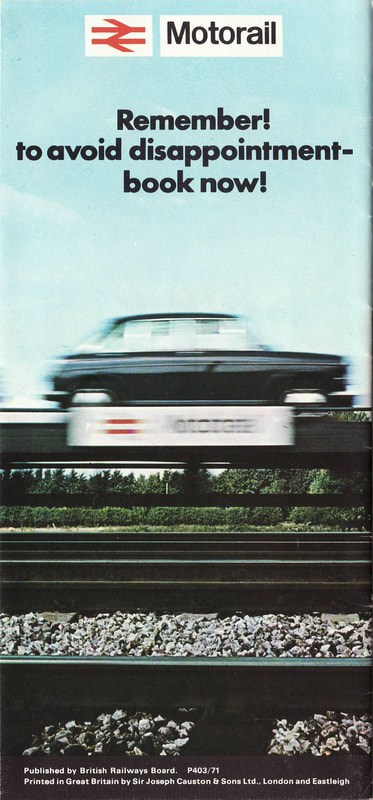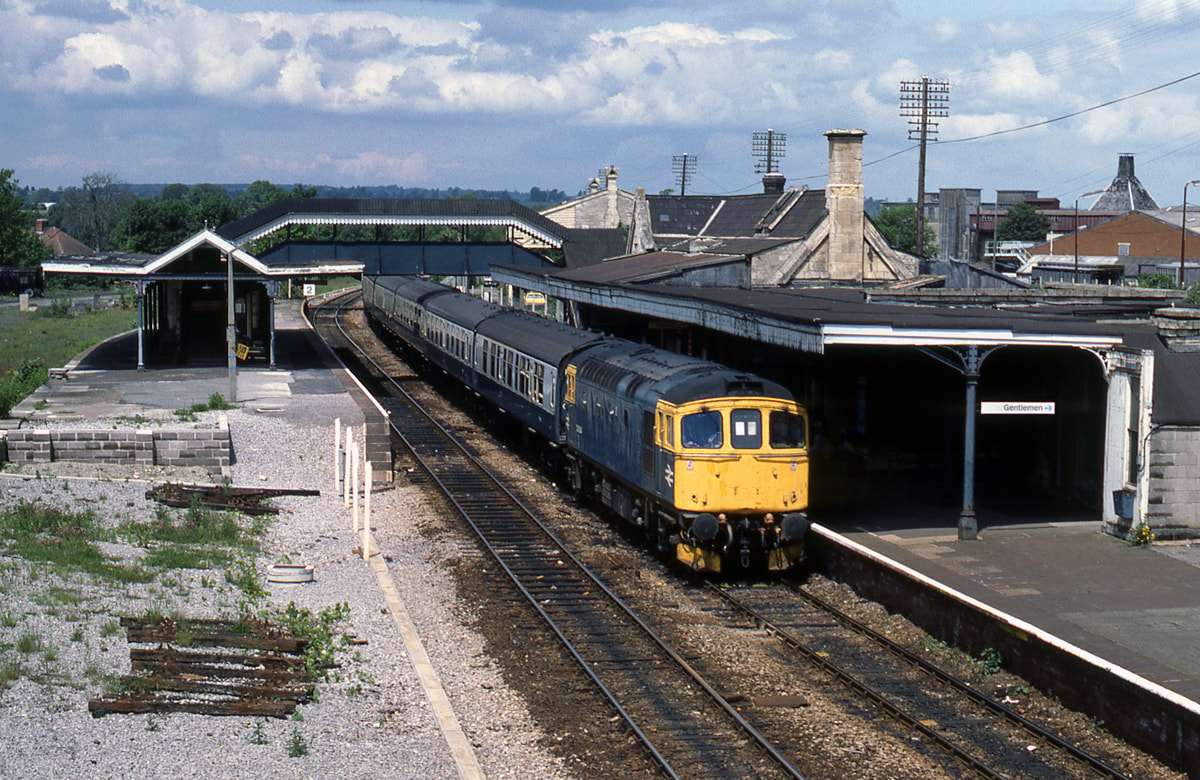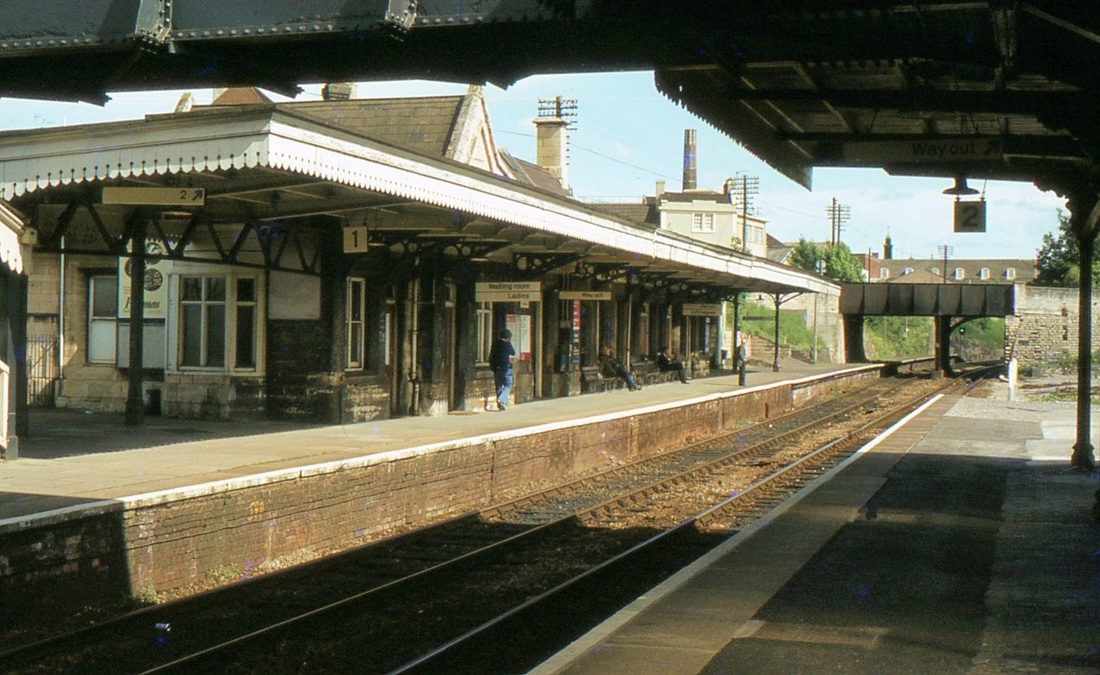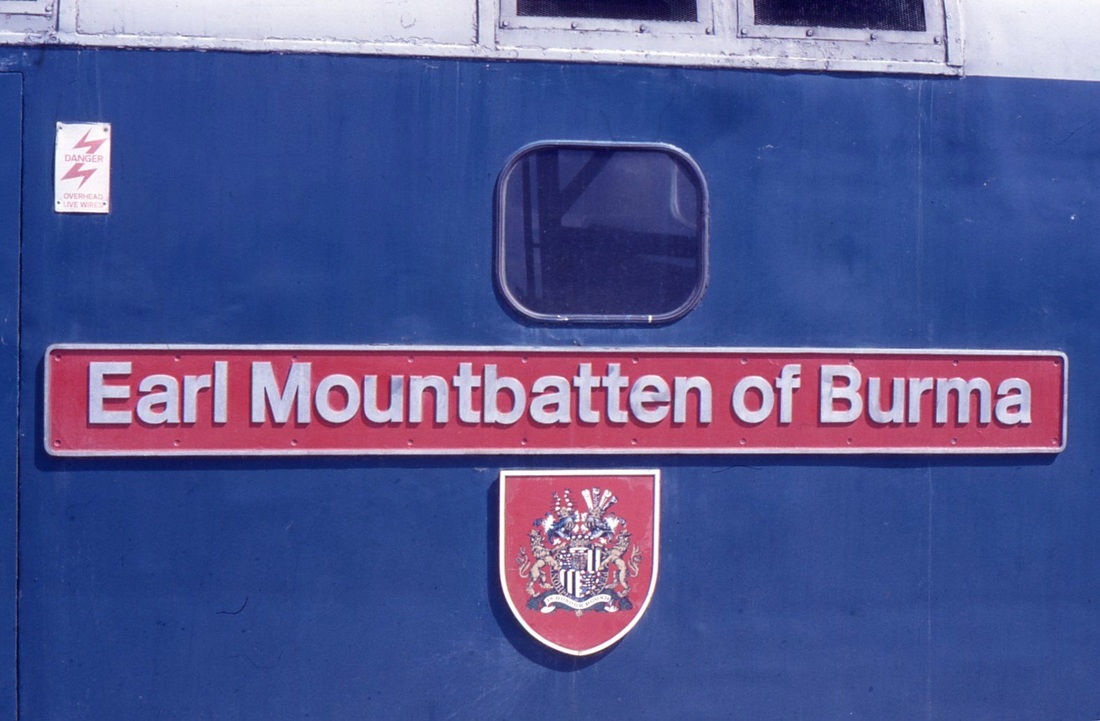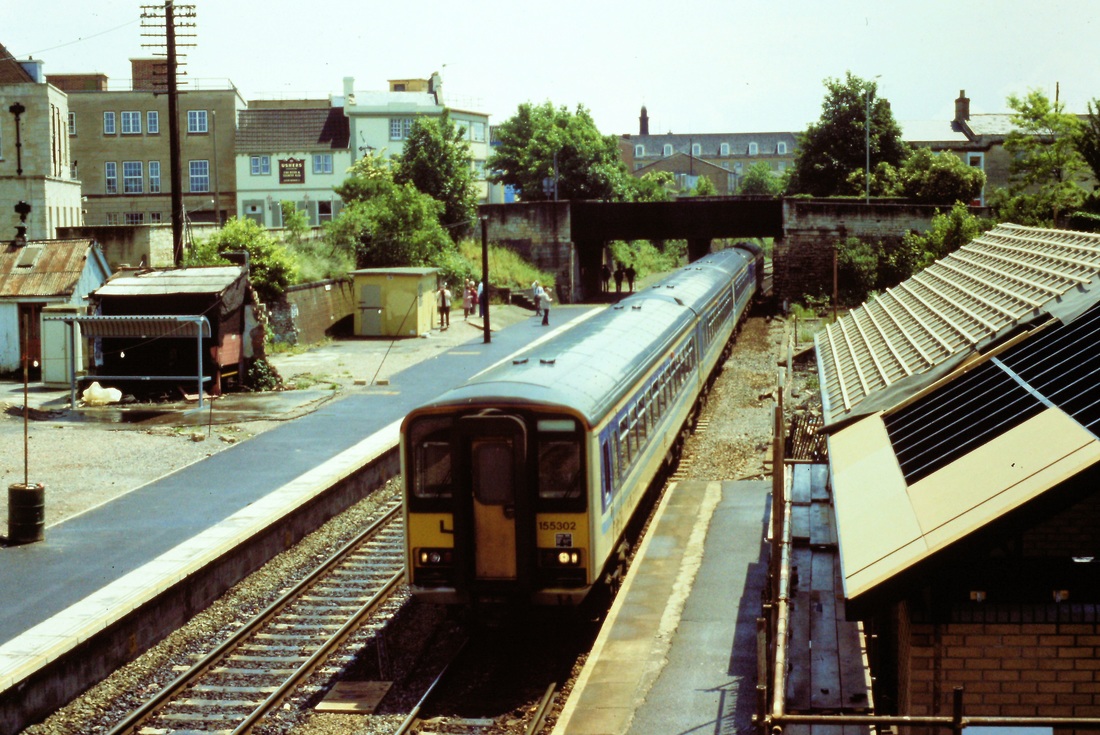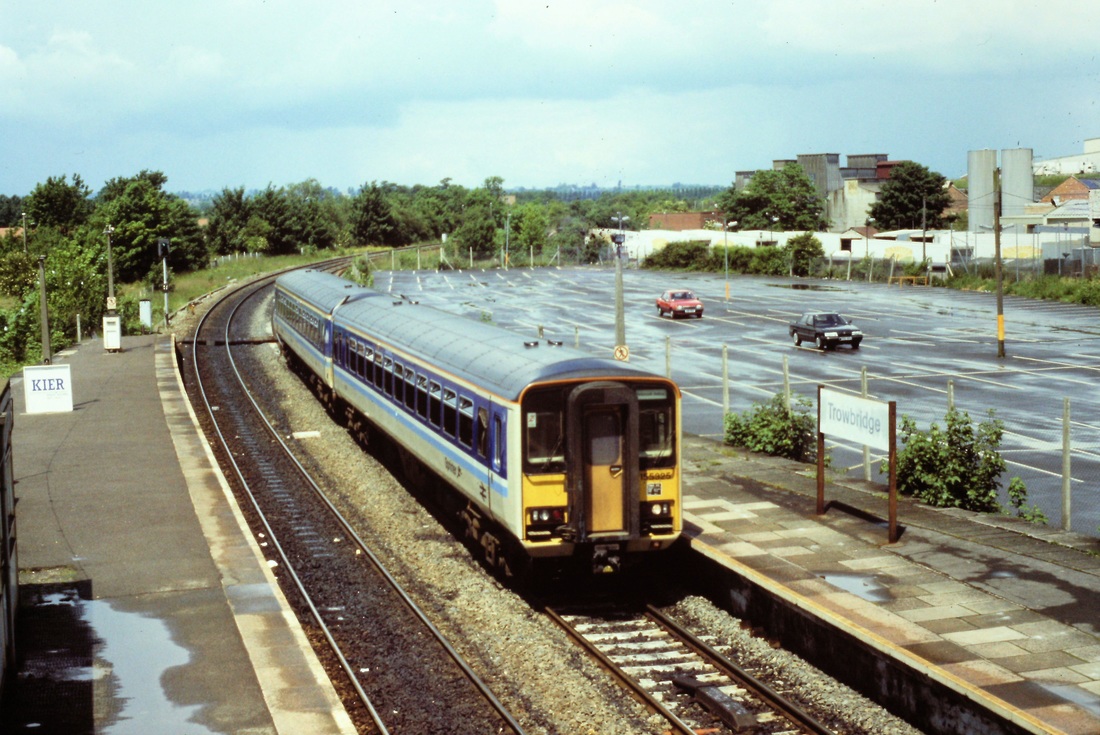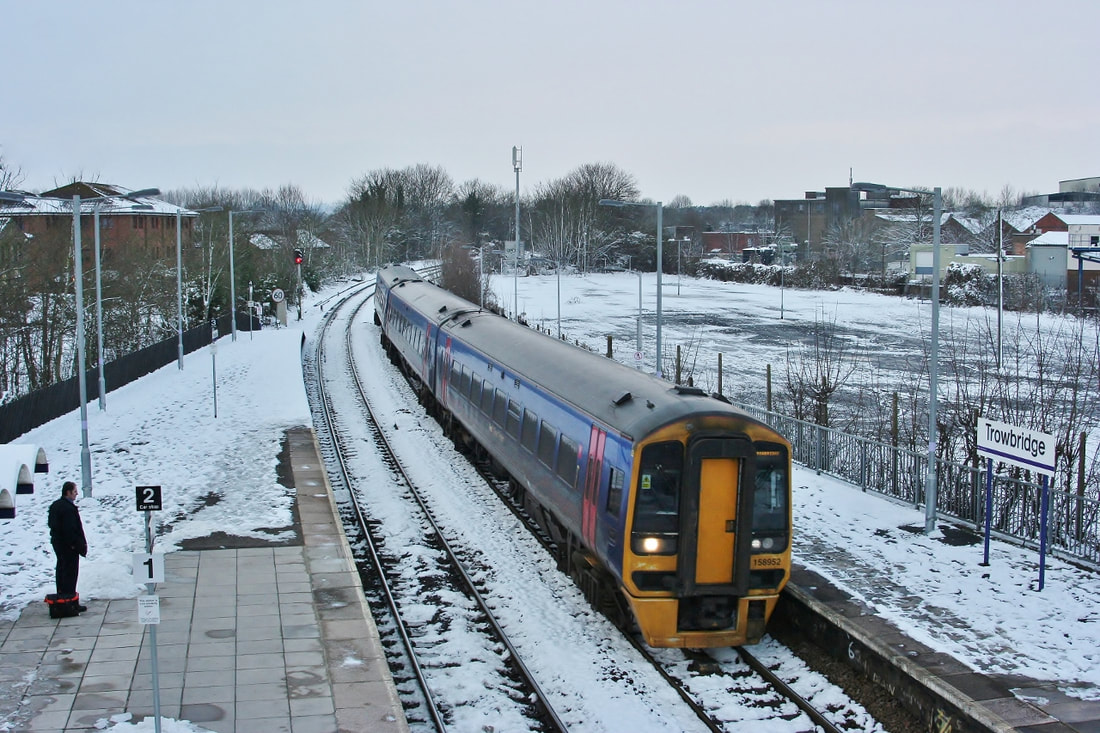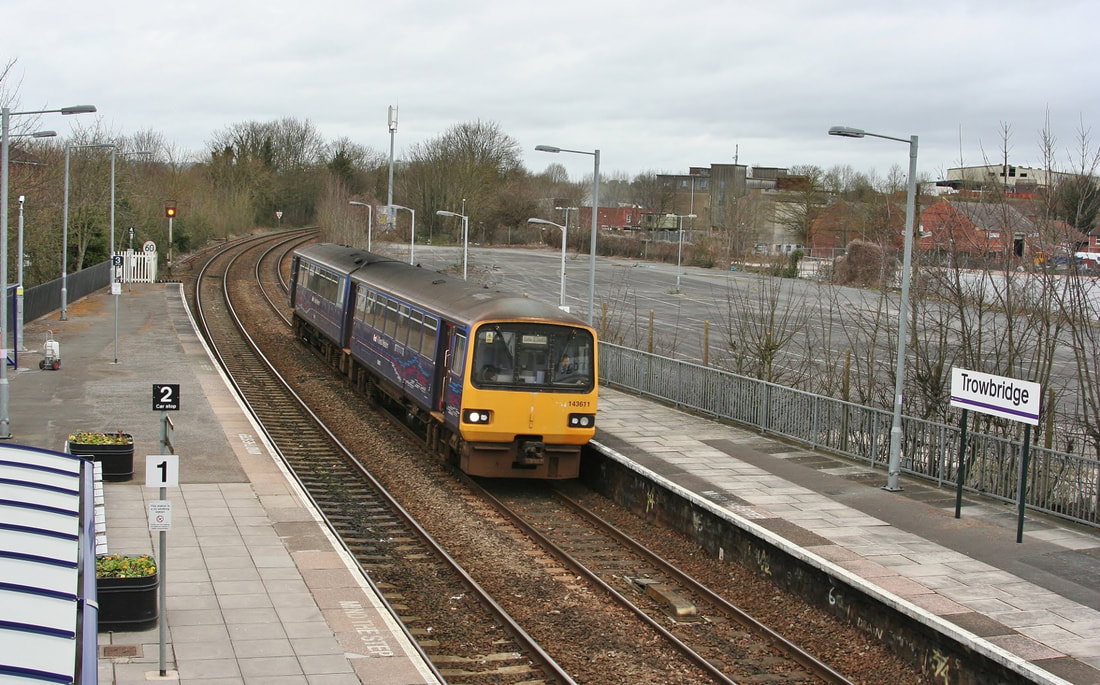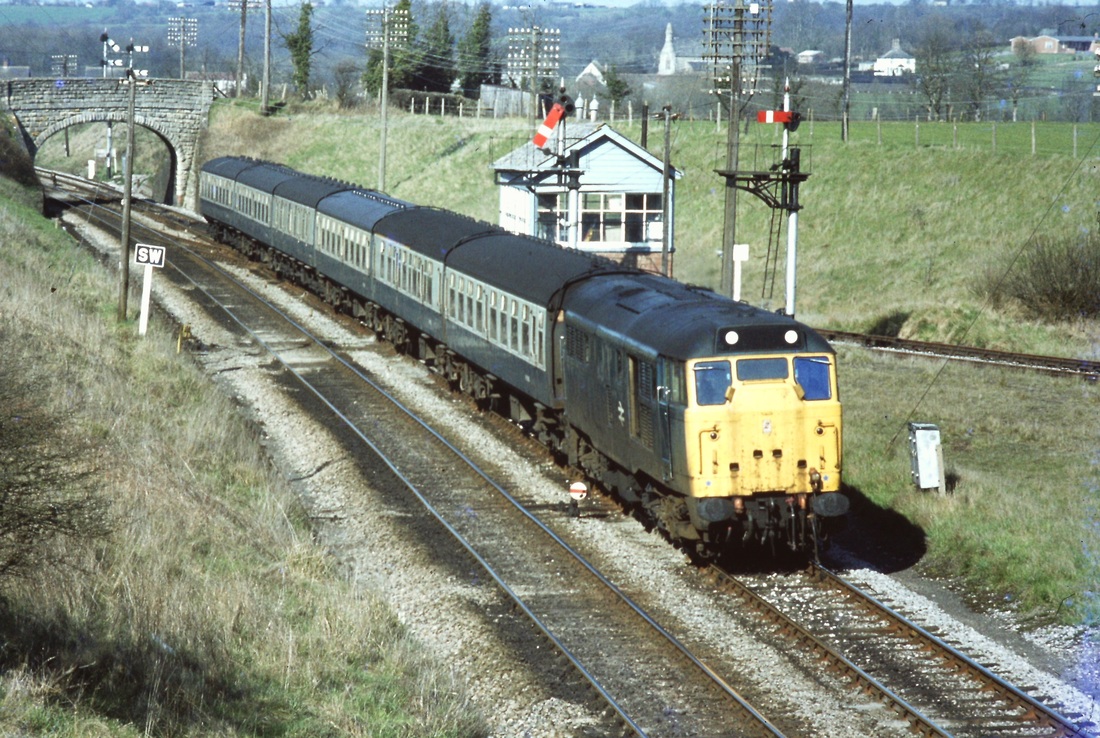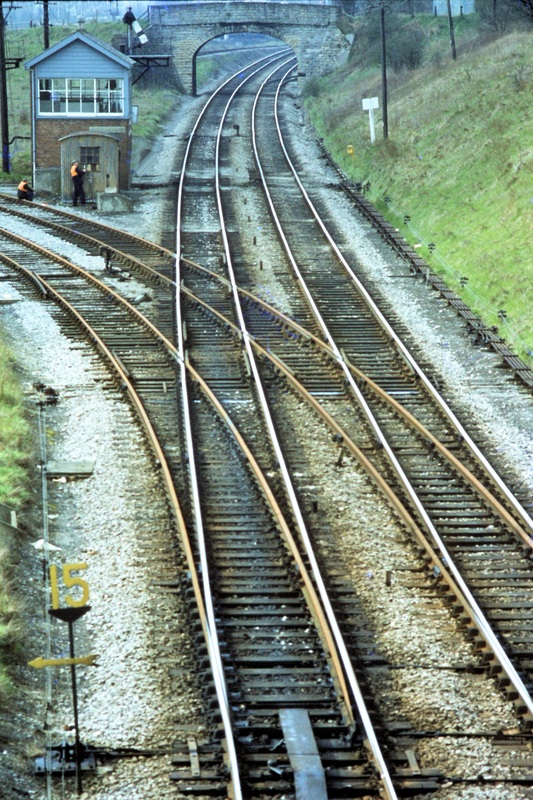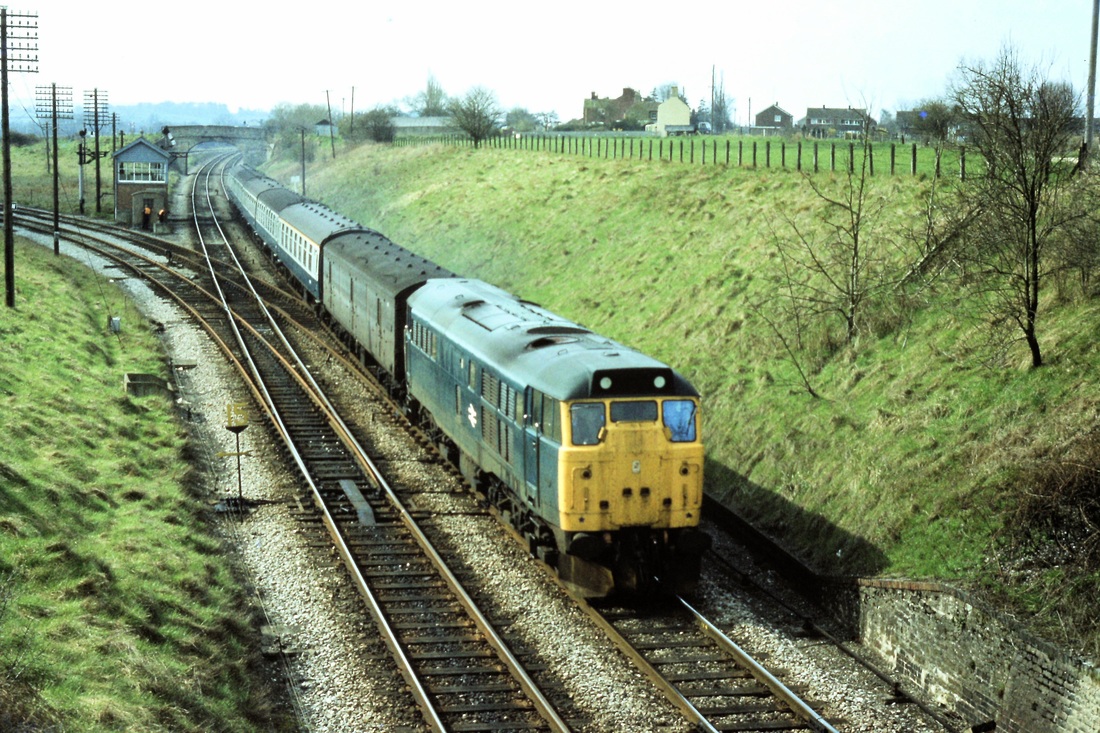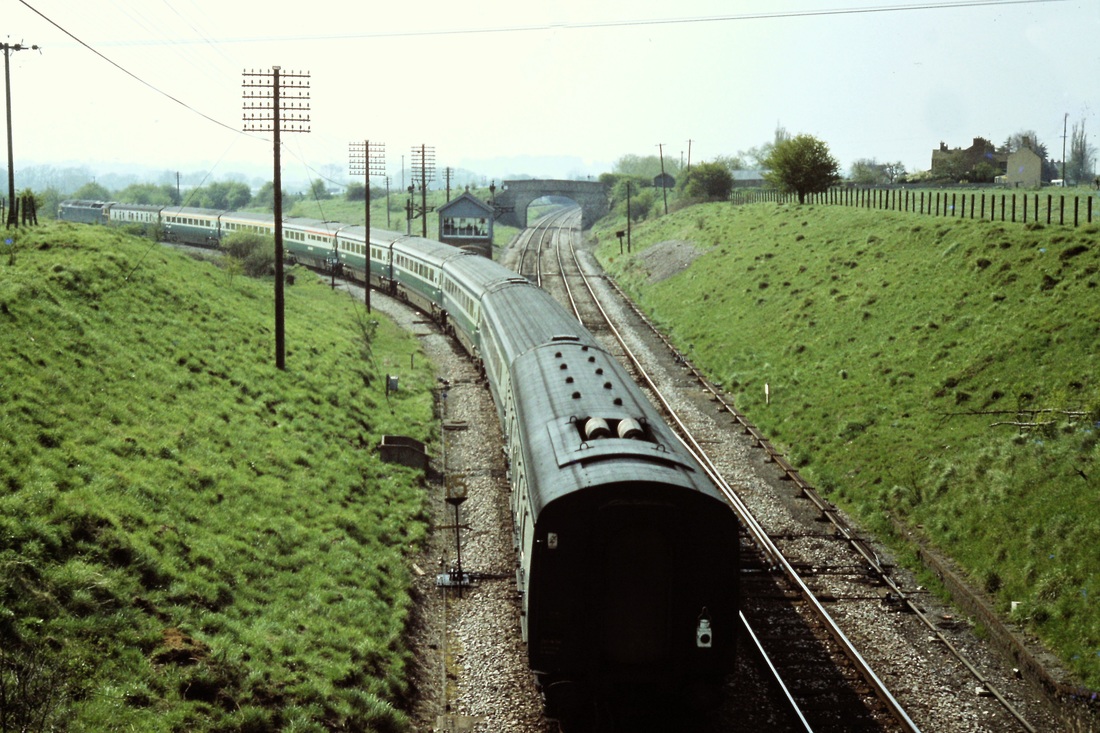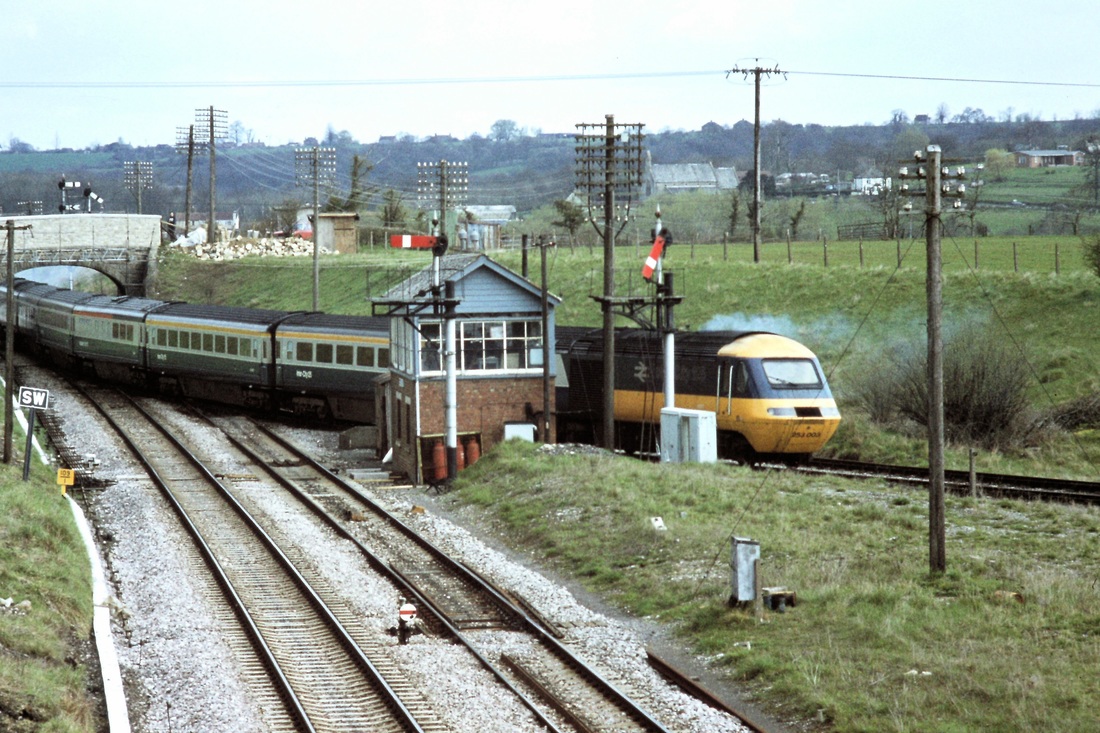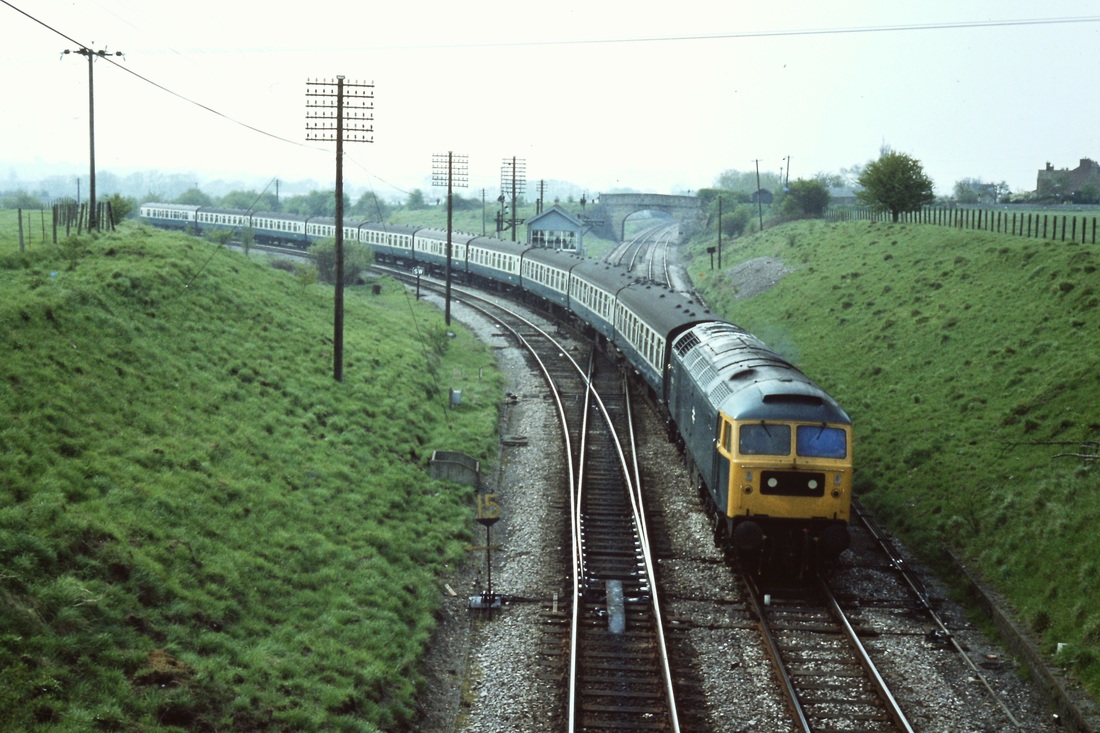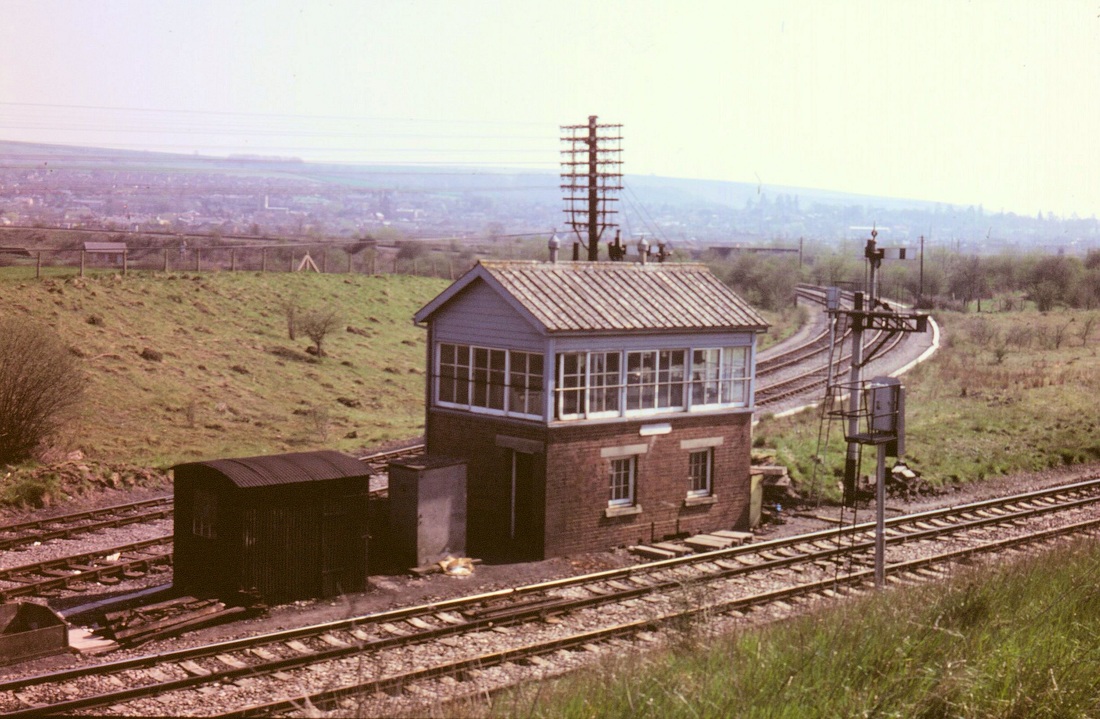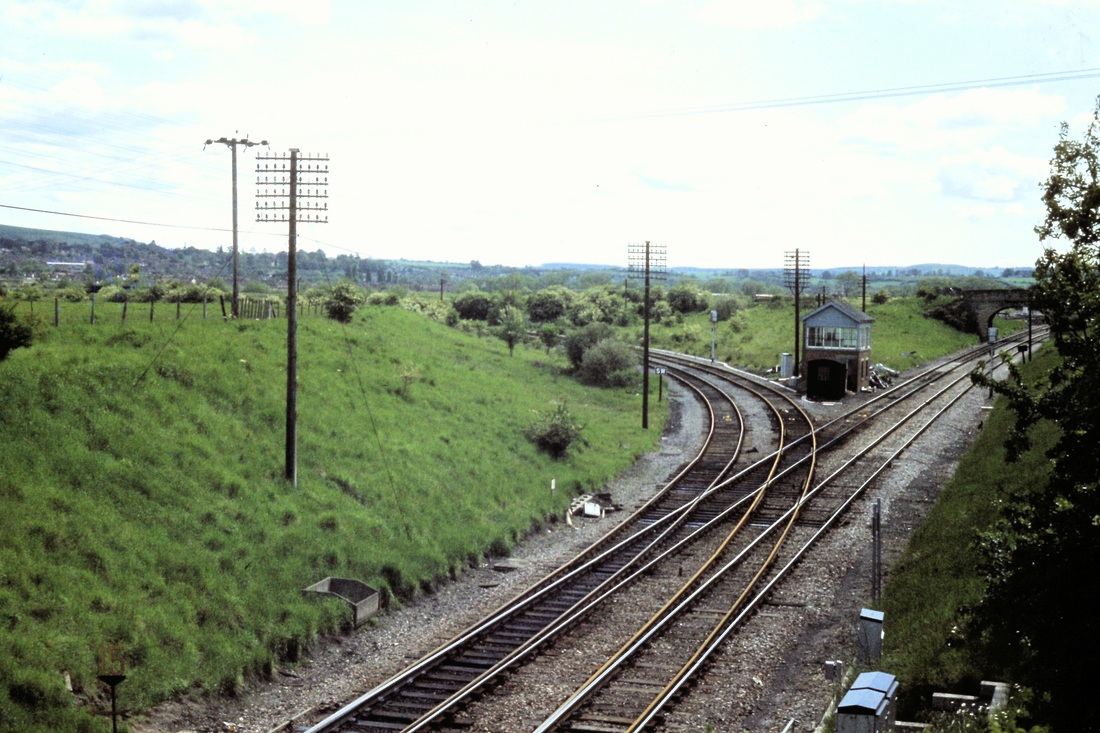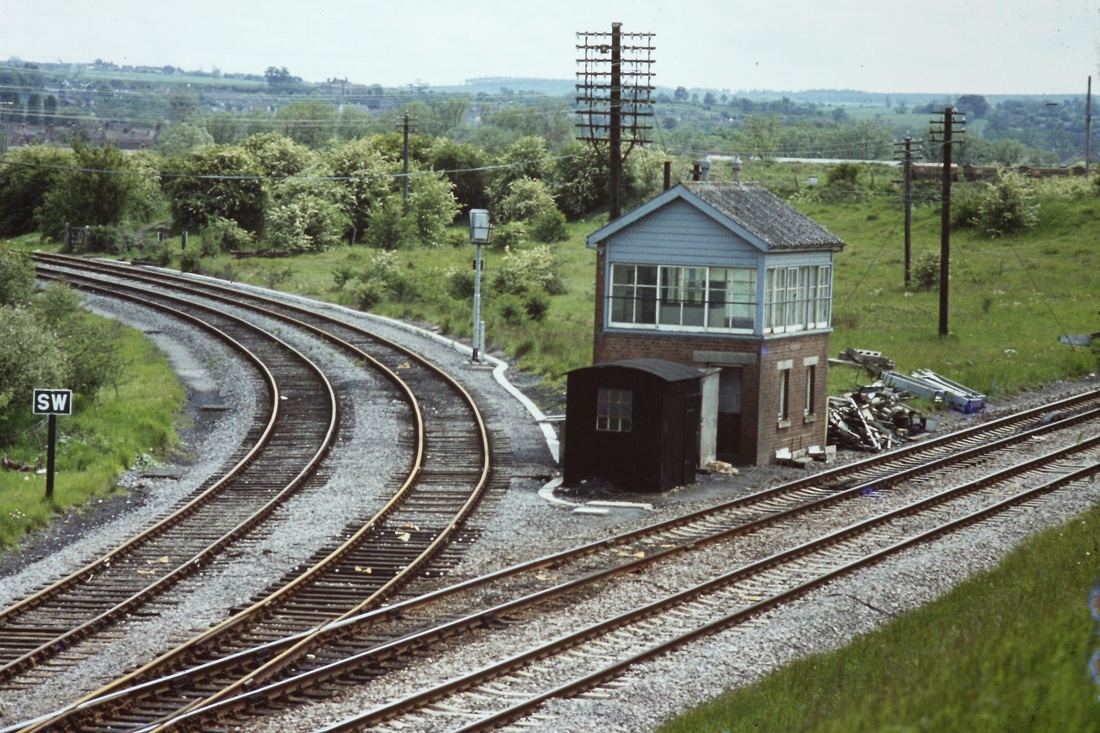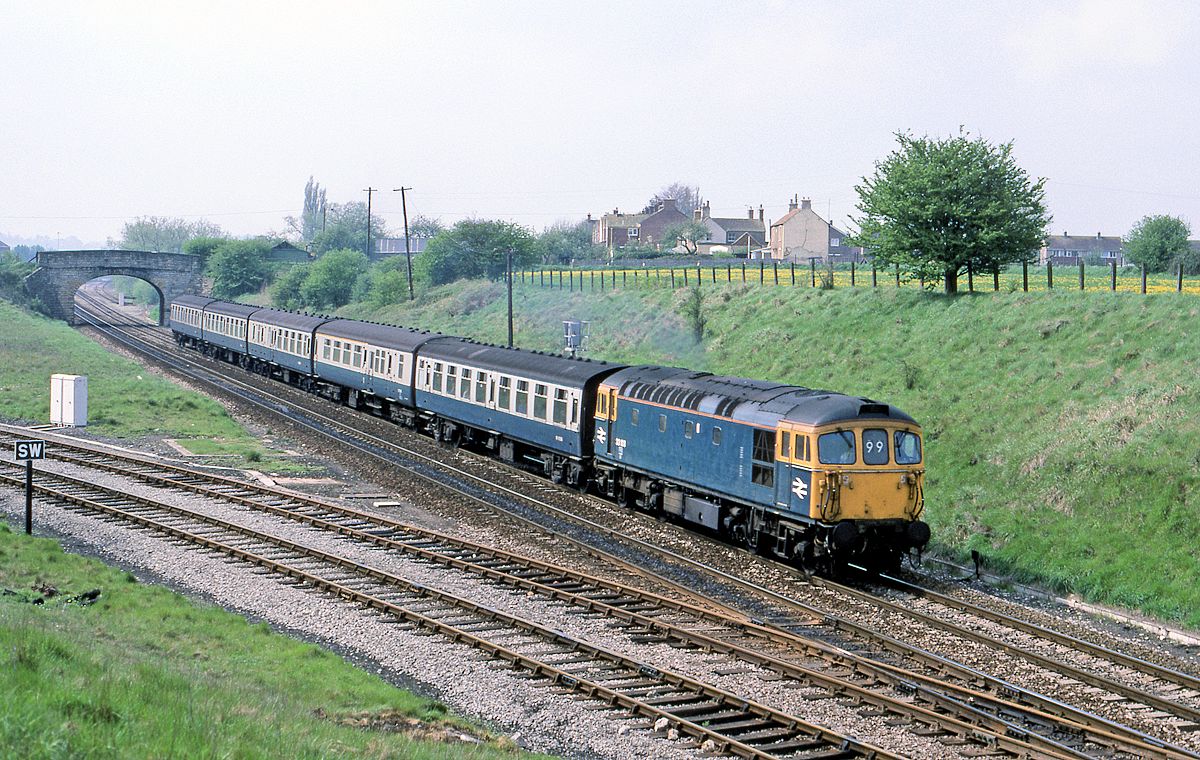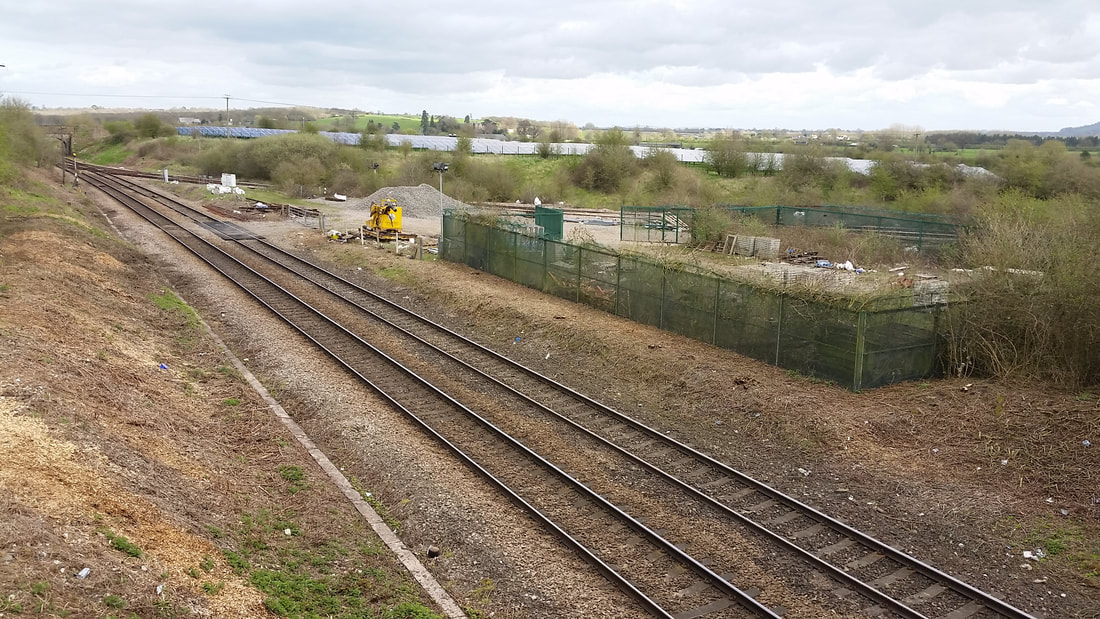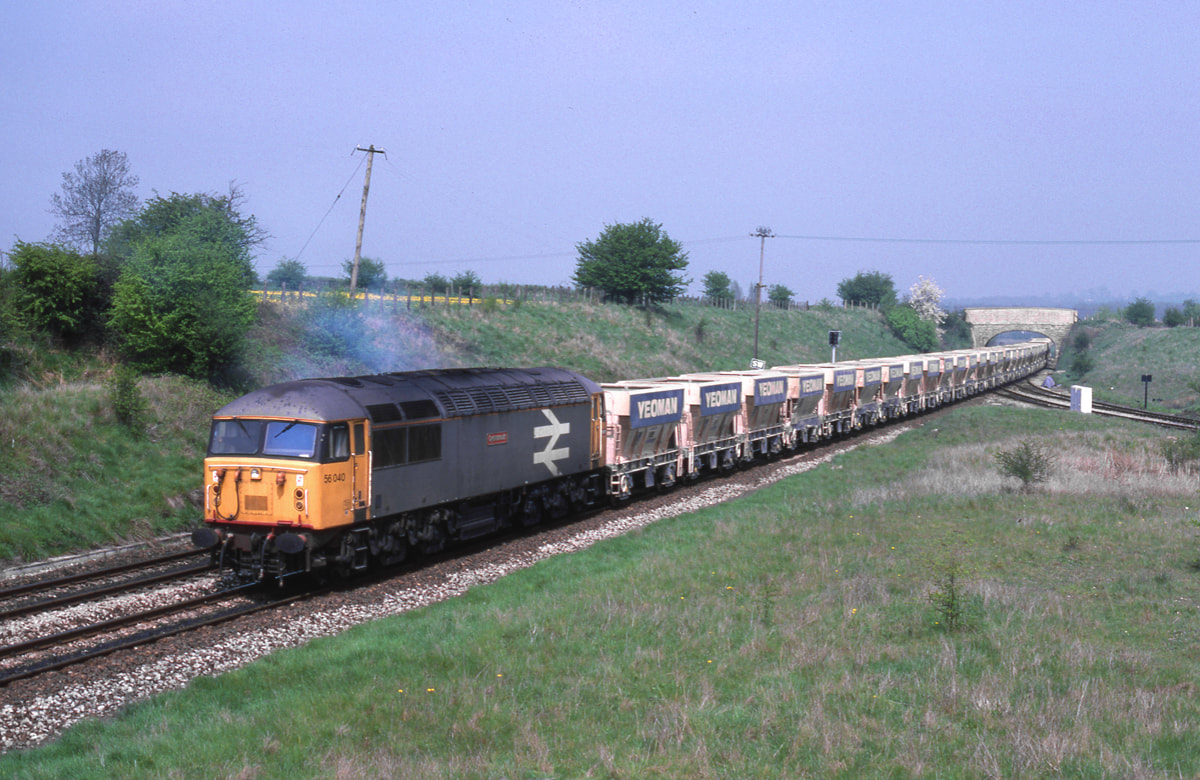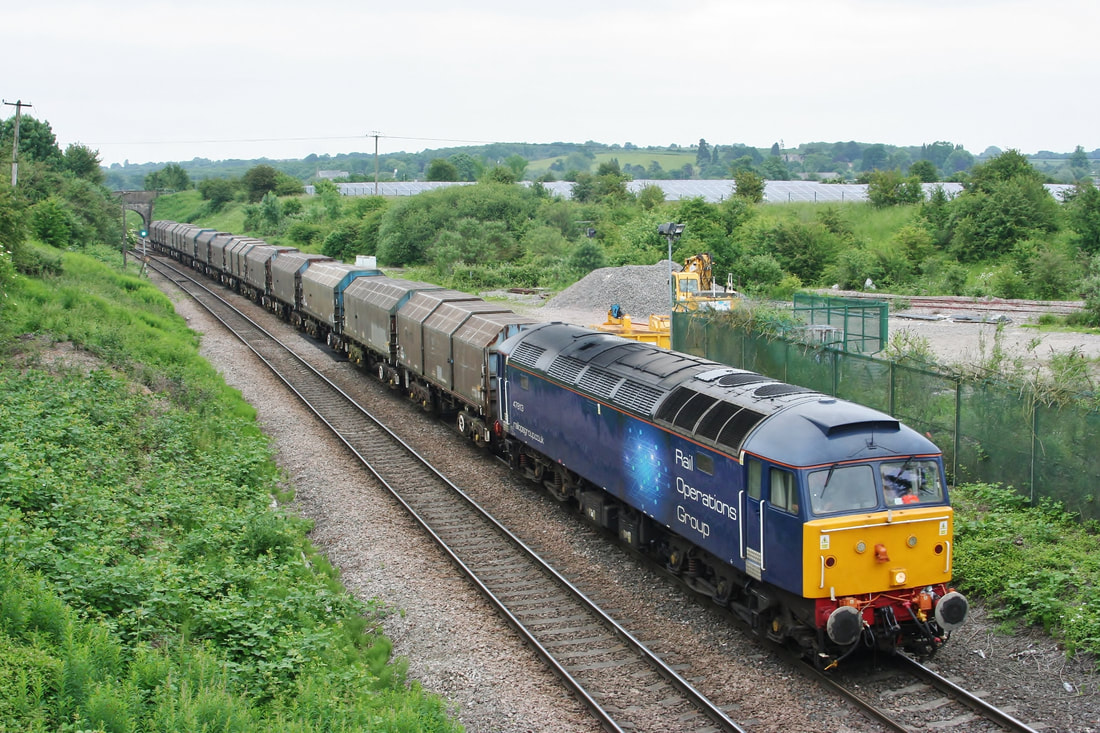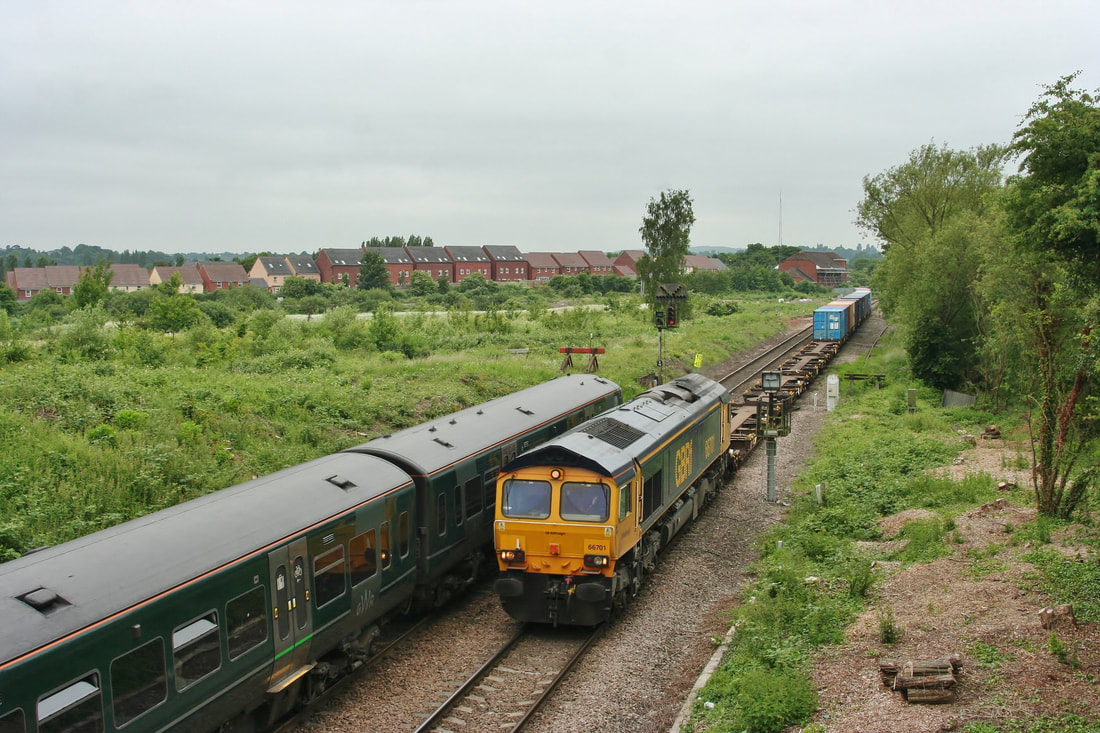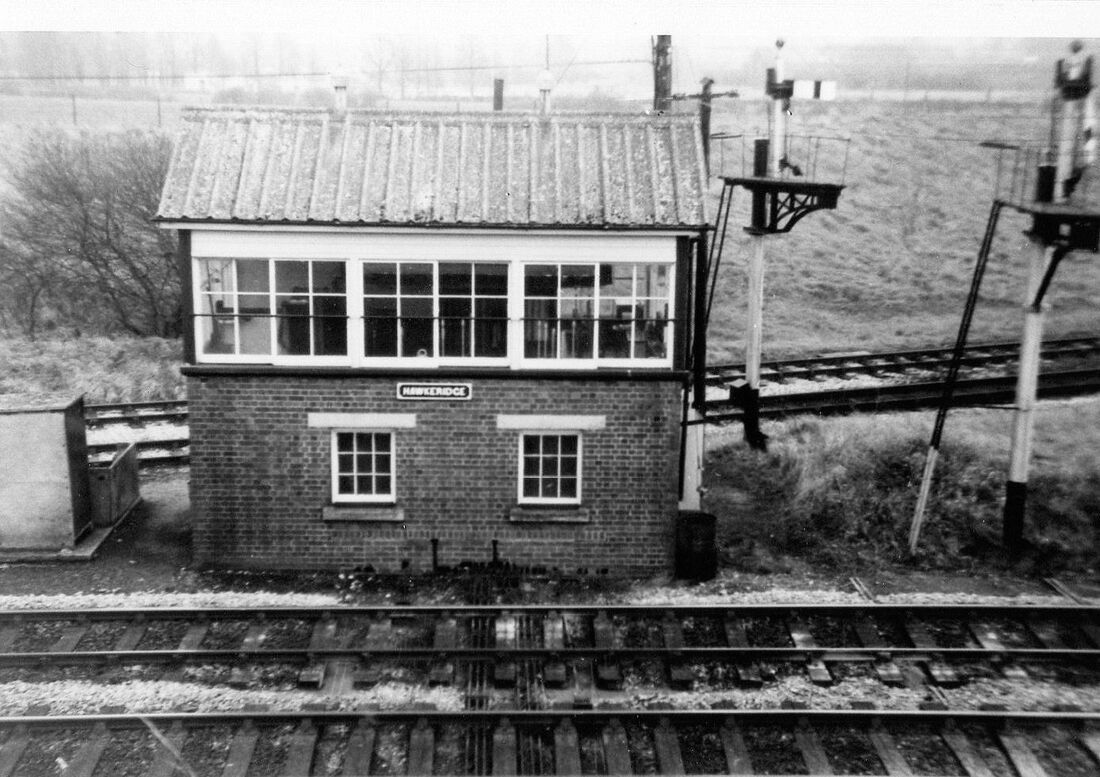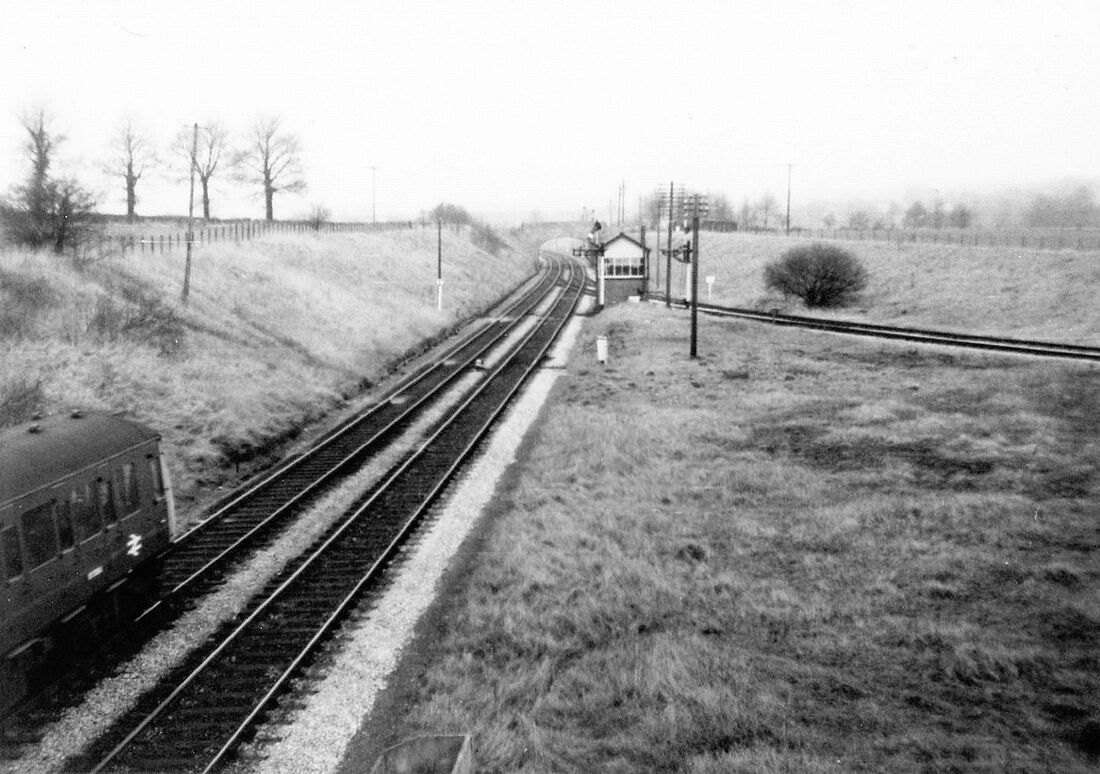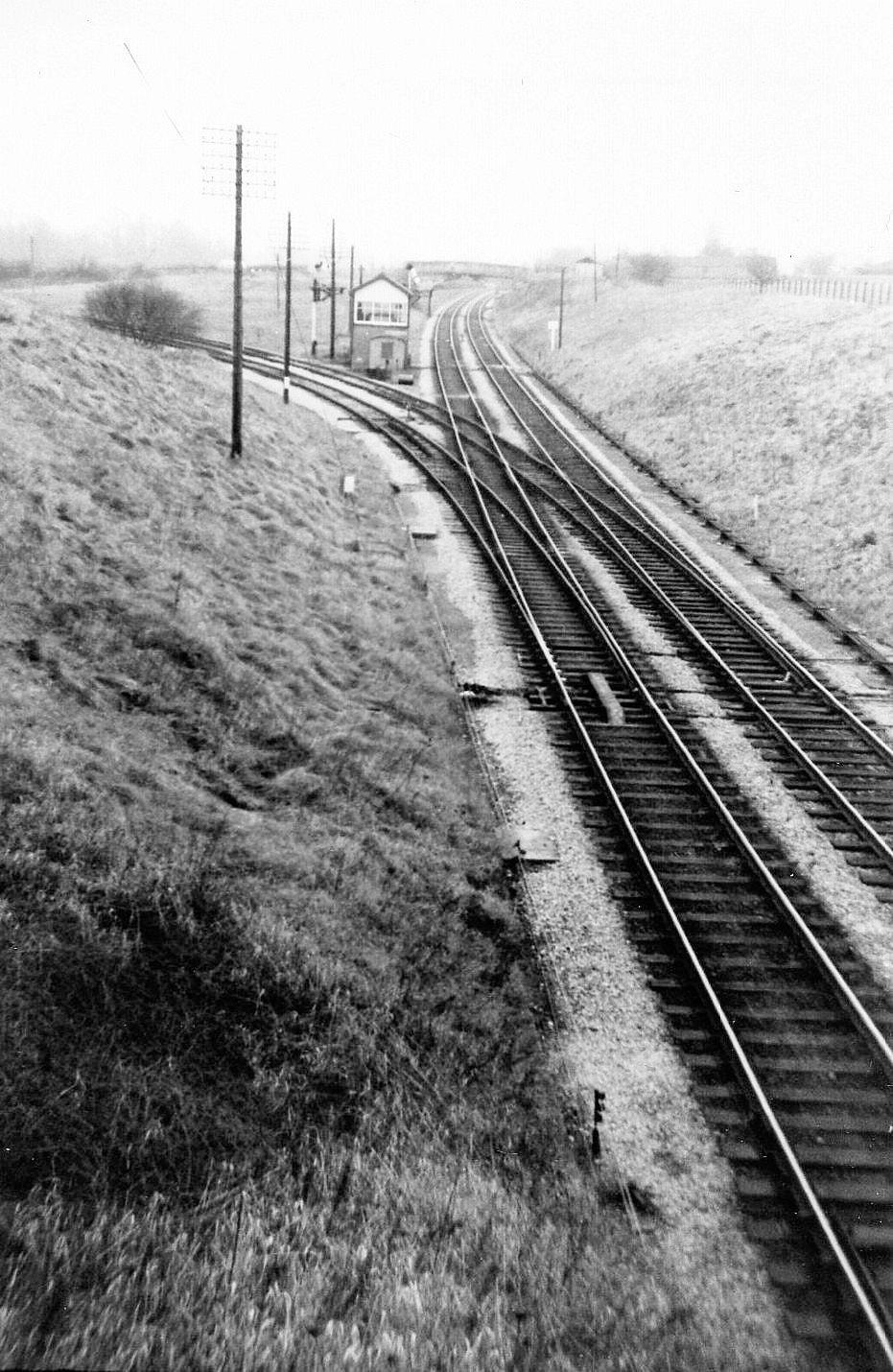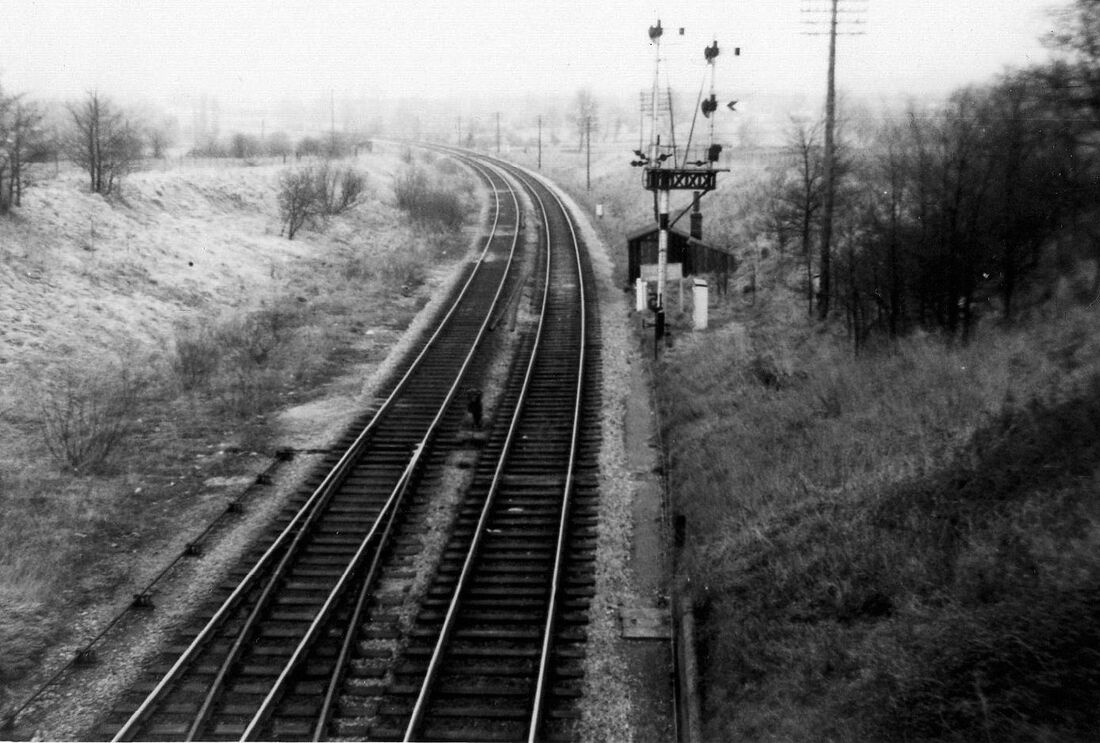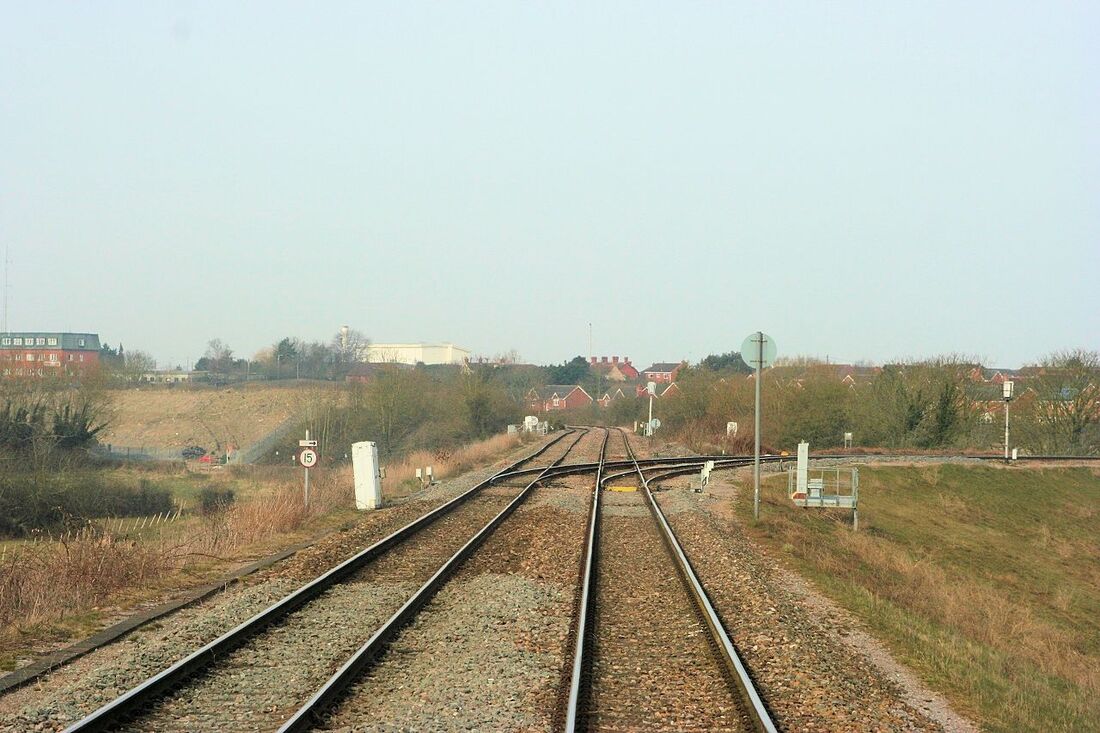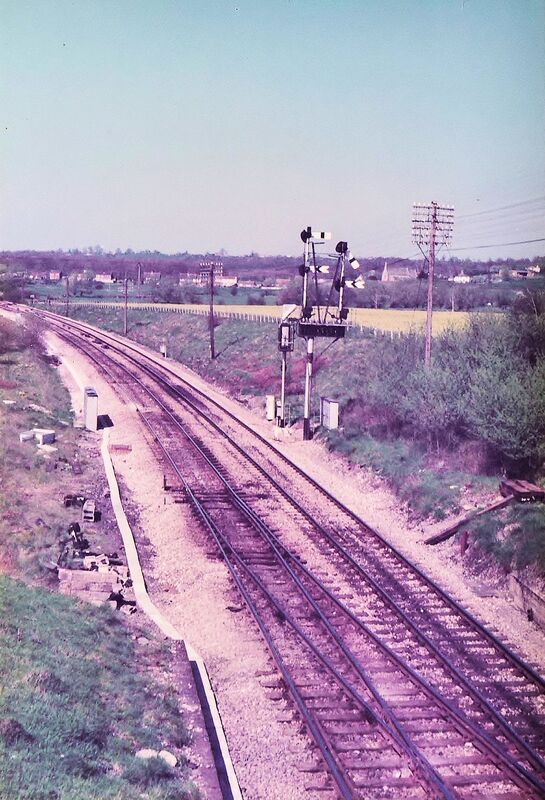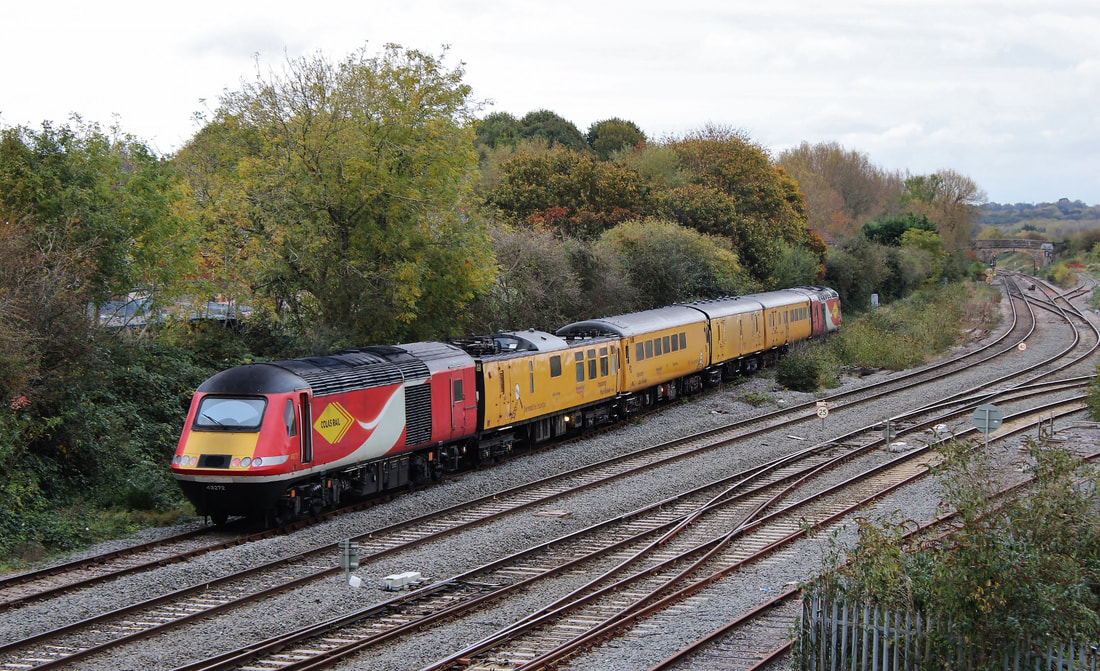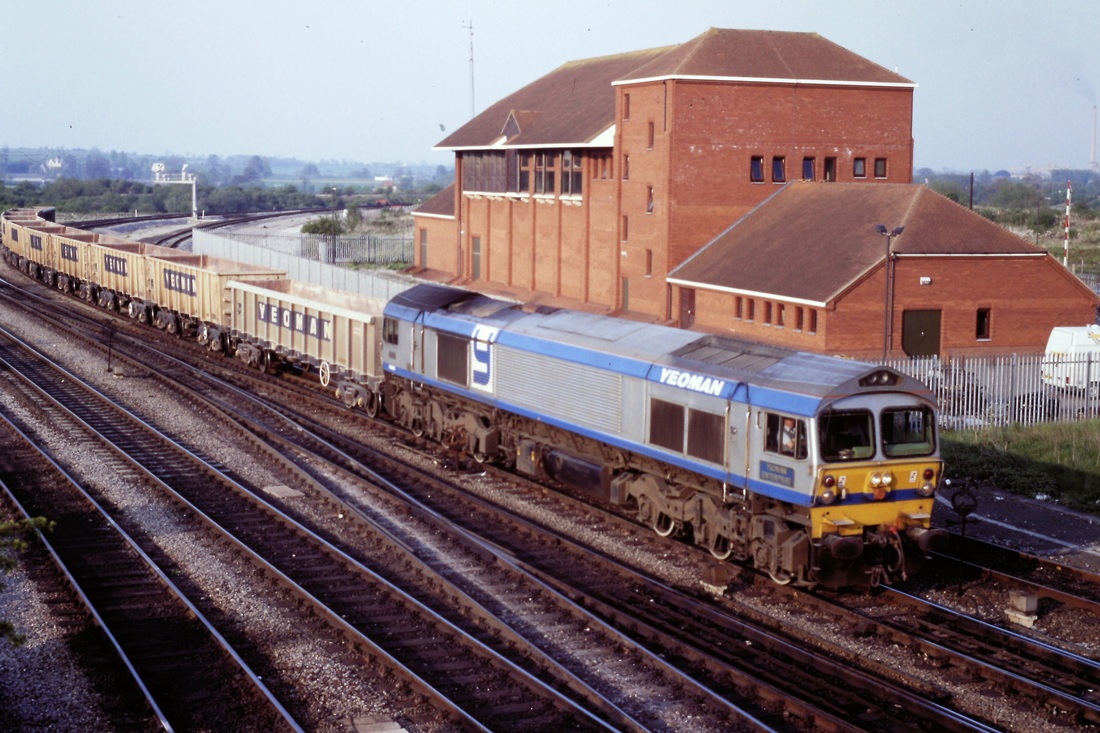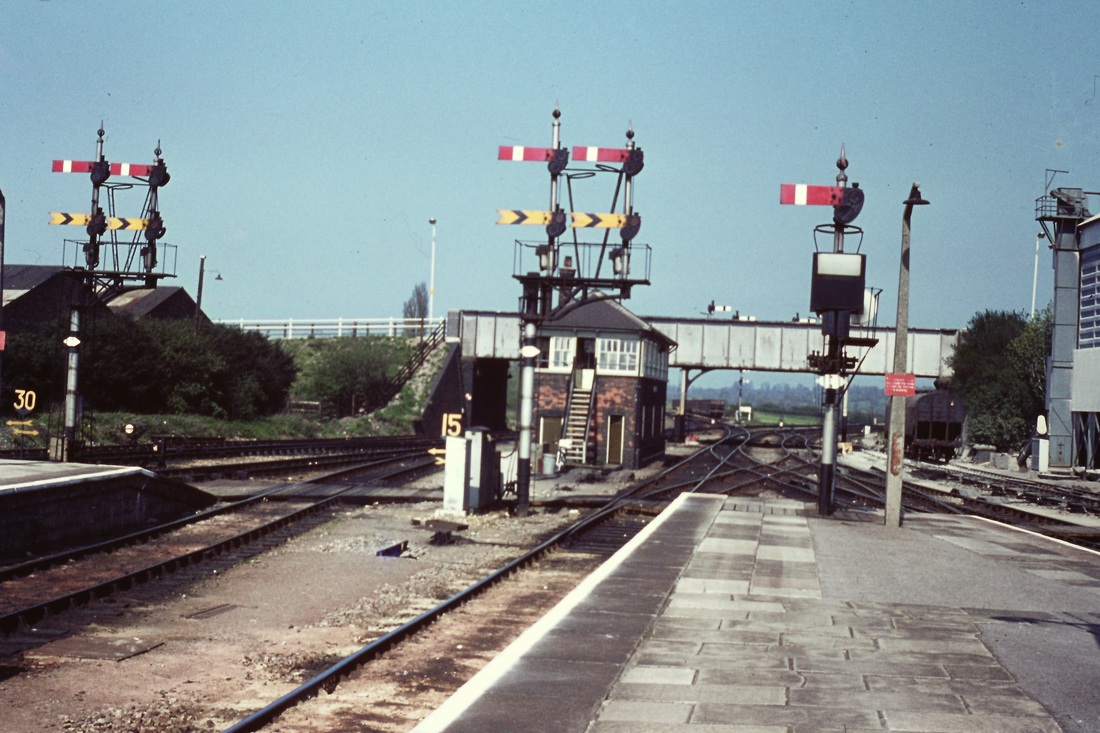Bradford on Avon (Excl)
to Westbury
to Westbury
Bradford Junctions
Some two miles south of Bradford on Avon lay a triangular junction known as Bradford Junctions. The junction joins the Wilts, Somerset and Weymouth railway to Westbury (O 1848) with the Westbury to Bath line (O 1857). A link line, the Bradford on Avon Loop opened in 1895, this being an early casualty closing in March 1990. The individual junctions being named West, South and North. The North being at the junction of the lines from Bradford on Avon and those towards Melksham and Thingley. Each of these junctions had, at one time, an individual signalbox. The functions of these three boxes being taken over on the 2nd May 1933 by a single box called Bradford Junction located on the Thingley curve. It is recommended that you take a look at Google Earth at 50 deg 20' 20.49" North and 2 deg 12' 41.77 East which will bring you to the centre of the triangle and give an aerial view of no less that three trains. (Or simply 'key in' Trowbridge - the triangle is to the NW). Two passenger trains are on the Bradford Curve and one empty stone train waiting on the Thingley curve. Also visible is the empty trackbed of the Bradford on Avon Loop. The aqueduct which carries the Kennet and Avon Canal over the metals about a quarter of a mile south of the south junction provides a good observation point for some of the activities as can be seen below.
Some two miles south of Bradford on Avon lay a triangular junction known as Bradford Junctions. The junction joins the Wilts, Somerset and Weymouth railway to Westbury (O 1848) with the Westbury to Bath line (O 1857). A link line, the Bradford on Avon Loop opened in 1895, this being an early casualty closing in March 1990. The individual junctions being named West, South and North. The North being at the junction of the lines from Bradford on Avon and those towards Melksham and Thingley. Each of these junctions had, at one time, an individual signalbox. The functions of these three boxes being taken over on the 2nd May 1933 by a single box called Bradford Junction located on the Thingley curve. It is recommended that you take a look at Google Earth at 50 deg 20' 20.49" North and 2 deg 12' 41.77 East which will bring you to the centre of the triangle and give an aerial view of no less that three trains. (Or simply 'key in' Trowbridge - the triangle is to the NW). Two passenger trains are on the Bradford Curve and one empty stone train waiting on the Thingley curve. Also visible is the empty trackbed of the Bradford on Avon Loop. The aqueduct which carries the Kennet and Avon Canal over the metals about a quarter of a mile south of the south junction provides a good observation point for some of the activities as can be seen below.
For a 25" to the mile map of the junctions in 1902 - courtesy National Library of Scotland. Click below ;-
maps.nls.uk/geo/explore/#zoom=17&lat=51.3395&lon=-2.2122&layers=168&b=1
maps.nls.uk/geo/explore/#zoom=17&lat=51.3395&lon=-2.2122&layers=168&b=1
Just before Bradford West Junction
Going east from Bradford and located at the site of the former Bradford West Junction is another elderly and rare survivor. A wrought iron 'caisson' bridge that dates from around 1890 and takes the line across the river Avon and adjoining land. Similar bridges at Bradford-on-Avon and at Staverton on the Melksham line were both replaced in the 1960s but this one stubbornly hangs on!
Bradford West Junction Twenty three and a quarter miles from BTM
Bradford South Junction Plus two chains on the west mileage
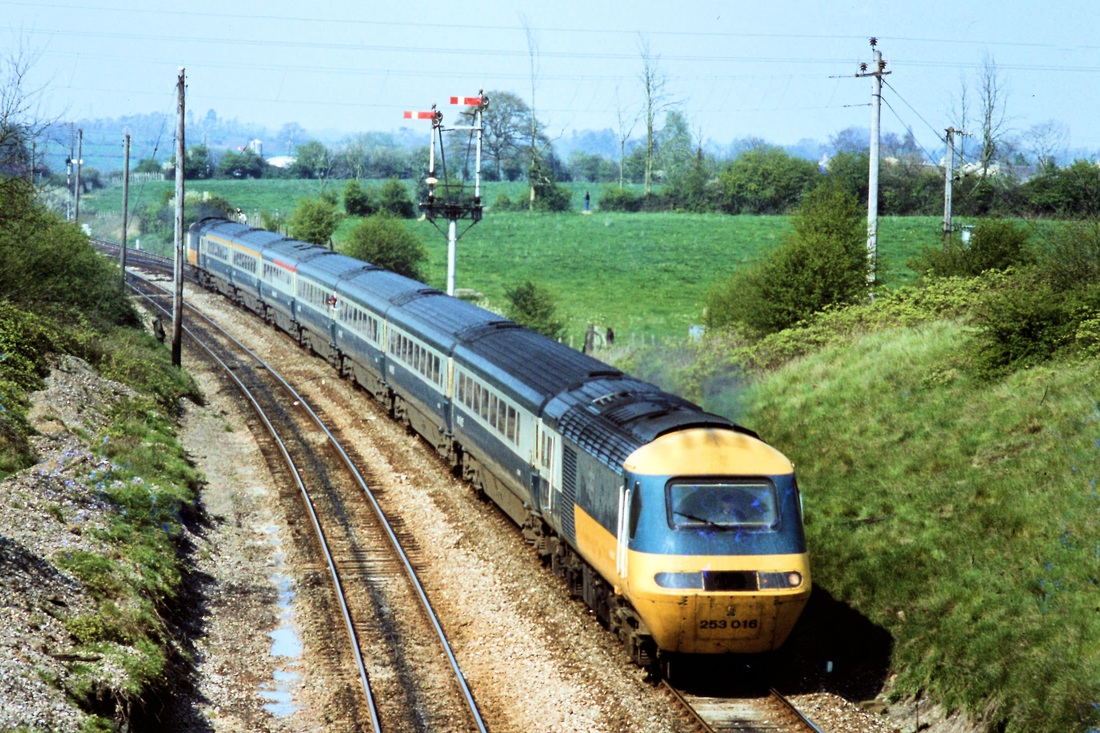
The down service has now joined the line from Bathampton Junction and will continue via Trowbridge and Westbury. Of the two bracket signals facing the phtographer the higher one indicates a higher line speed for the route towards Thingley Junction rather than that around the sharp curve towards Bradford on Avon and Bathampton. Copyright Roger Winnen.
Bradford Junction Signalbox. Approx 108 miles 23 chains from London.
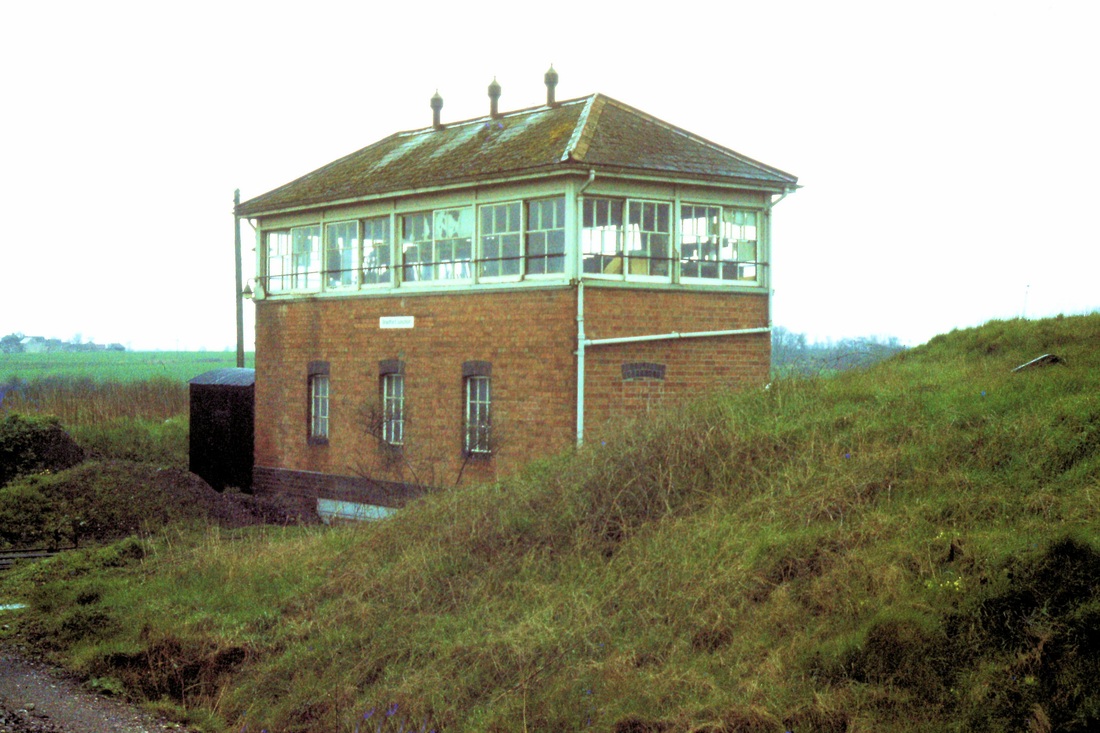
This signalbox lay alongside the metals from Bradford South Junction towards Thingley Junction. The picture was taken from the window of a HST which was from London then via Chippenham, Westbury and Salisbury to Penzance. 24th April 1983 Copyright Roger Winnen - N.B The box closed 17th March 1990 six days after the singling of Bradford South Junction.
Trowbridge Twenty four miles from BTM
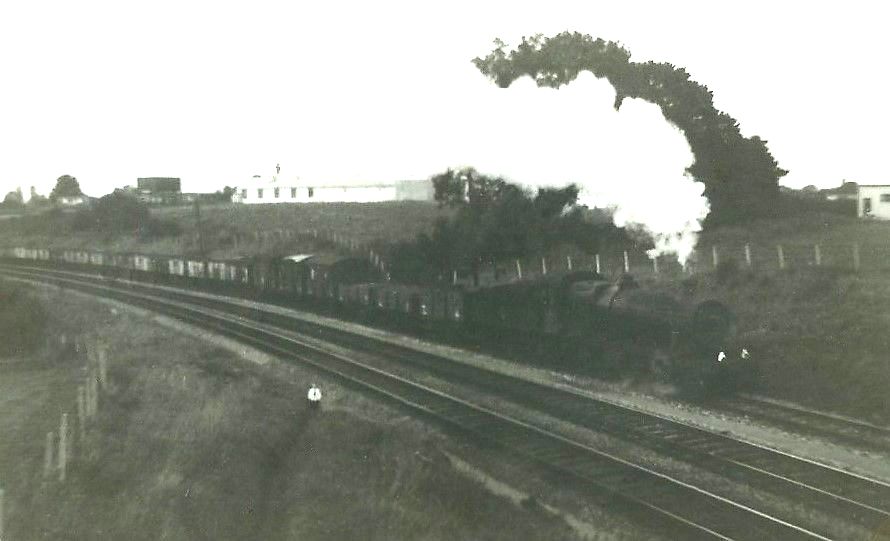
Martin writes ' Here is very poor quality (so no worries if it fails the acceptability test !) but it is interesting as it shows a pretty lengthy goods heading towards Trowbridge from Bradford on Avon. The interesting bit is that it is on the freight loop. Taken from our favourite spotting location of Black Bridge at Ladydown on the outskirts of Trowbridge.
The locomotive is 3864. My date (which is a little unreliable) is July 1964 which would fit as 3864 was a Neath engine at the time and this is likely a freight from South Wales headed for Westbury and Salisbury'. Many thanks indeed - copyright Martin Scane
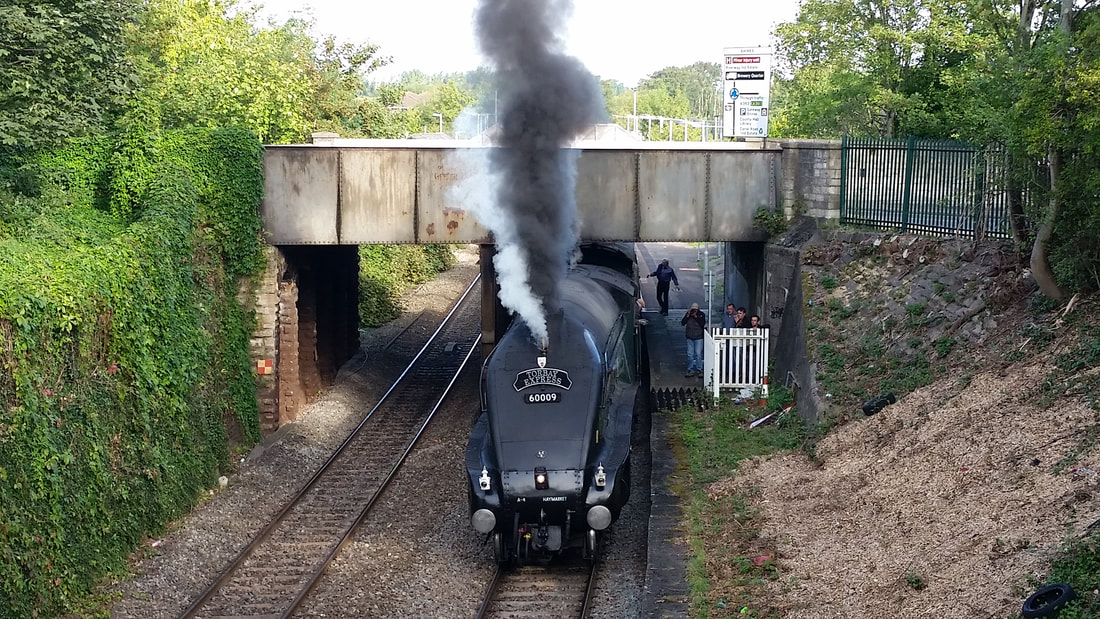
60009 'Union of South Africa' departing Trowbridge on the last 1Z27 0800 Bristol TM-Kingswear (for Dartmouth) 'Torbay Express' of 2019. The bridge above the loco carries Stallard Street, one of the main routes to and from the town. Until the late 1980s a large cast iron GWR sign was affixed to the left side wall that read 'Engines must not stand under this bridge'. This image demonstrates a good reason why the notice was needed in steam days! 8th September 2019. Copyright Guy Vincent.
Guy Vincent writes :- I noticed the old 'Travelling Safe' on the down platform at Warminster waiting to be put onto what I think was the 1007 Bristol Temple Meads-Portsmouth Harbour train hauled by 47543 in May 1988. I remember that there used to be a train-operated bell that rang as 'down' trains passed Upton Scudamore summit approximately 2 miles away towards Westbury and this just gave the duty porter / parcels clerk time to cross from the up-side parcels office ready to deal with any items requiring loading or unloading. Prior to 1988 when the present station building was constructed on the opposite side to the original, a similar bell was used at Trowbridge for exactly the same purpose and sounded when trains passed Hawkeridge Junction soon after leaving Westbury. Many thanks Guy
You recently featured some interesting Motorail publicity supplied by Roger Salter and this reminded me of a large black and white photograph that was once displayed in the booking office of the old Trowbridge station. The photo was taken from towards the front of a diverted a Motorail train north of the station on the large radius curve leading towards Bradford Junction. When the station was demolished in 1984 the picture was apparently saved for posterity by one of the booking office staff but it's current whereabouts are unknown. Quite by chance I came across a Motorail publicity brochure dating from 1971 featuring the very same image on the cover, in colour. I would guess that the photo dates from the summer of either 1970 or 1971 and features the tower of Holy Trinity church in the background. The area to the left of the running lines was occupied by sidings and a goods loop until September 1968, this has now been fenced off and given over to a public footpath that leads from the town to the Kennet and Avon canal close by Ladydown Aqueduct. Quite why Trowbridge was chosen for such a shot is open to debate. Consider the alternative locations up and down the country such as the Dawlish Sea Wall or the Devon Banks. BR cutbacks??! Guy Vincent Many thanks Guy
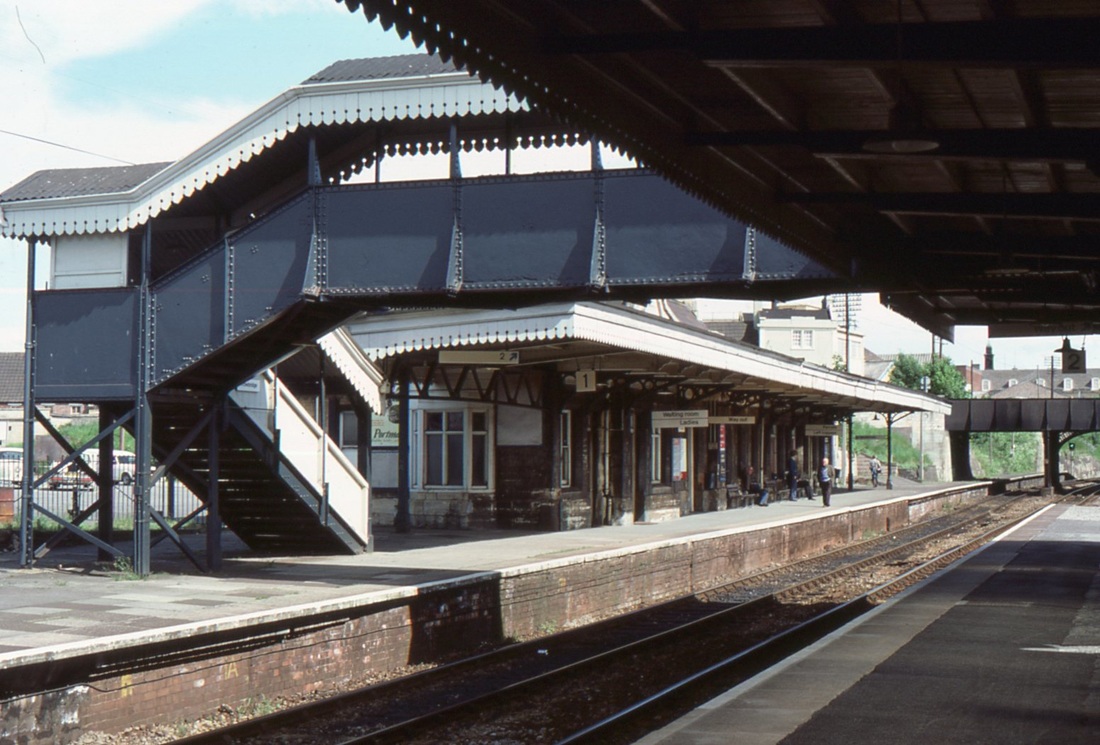
Trowbridge in all its glory, now the station building is a shadow of this structure. We're looking towards Westbury. However better things have happened on the other platform. 2nd June 1984 Copyright Mike Roach N.B. It is pleasing to note that this footbridge has found fresh use at Williton on the West Somerset. Quote Chris Osment.
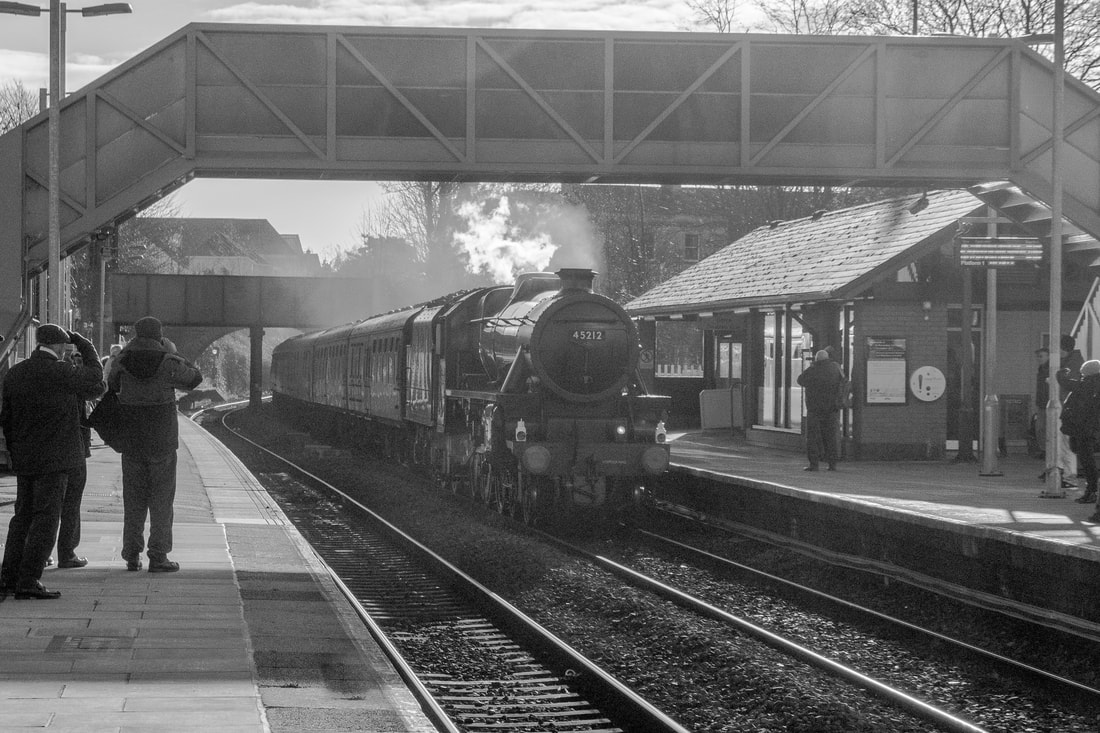
LMS Black 5 45212 eases through Trowbridge station on its way to Bath and Bristol. Here there is a 30mph speed restriction but just at the end of the platform the restriction eases to 60mph.
45212 was stabled at Swanage overnight and left there for Poole at 0550. 45212and its train (1Z87) picks up passengers at Poole at 0650 and heads to Southampton, Eastleigh and Salisbury where it takes water. It passed trowbridge a few minutes down and would stop at Bath for the Christmas Market and then onto Bristol Temple Meads.
The return trip starts at Bristol Temple Meads at 1736 returning via same route as far as Salisbury where 45212 comes off and goes back to Southall. The train returns to Poole with a 47 Class in charge. Copyright Terry Waldron
Hawkeridge Junction
Hawkeridge Junction Detailed notes supplied by Roy Hart
Hawkeridge was a World War Two creation. The box was opened to serve a new spur from Heywood Road Junction, enabling fast, heavy wartime trains to move from the Berks and Hants to the Trowbridge line avoiding the awkwardness of the old single line through Devizes. The box had two functions: control of the junction and acess to the large war department depot which lay to the top right of the diagram. This depot was sufficiently important to have facing-point access at either end (the Trowbridge end being motor points). The Trowbridge end connections were lifted soon after ww2, but the one across from the box was retained, spiked, on a 'just in case' basis until 1962, when it was lifted.
Hawkeridge box became a very quiet place after the war: from the 1950s onwards, the box was usually 'switched out' and only opened as required. The signalling record society classifies Hawkeridge as type 12 -one of the GWRs last designs. In Cornwall we had four of these: Penzance (1938) Baldhu (1938) Trerule (1938) and Newquay (1946).
In Roger's picture (2nd June 1984) , the lever frame and other equipment can be seen dumped outside the box.
Roy Hart Many thanks Roy
Hawkeridge was a World War Two creation. The box was opened to serve a new spur from Heywood Road Junction, enabling fast, heavy wartime trains to move from the Berks and Hants to the Trowbridge line avoiding the awkwardness of the old single line through Devizes. The box had two functions: control of the junction and acess to the large war department depot which lay to the top right of the diagram. This depot was sufficiently important to have facing-point access at either end (the Trowbridge end being motor points). The Trowbridge end connections were lifted soon after ww2, but the one across from the box was retained, spiked, on a 'just in case' basis until 1962, when it was lifted.
Hawkeridge box became a very quiet place after the war: from the 1950s onwards, the box was usually 'switched out' and only opened as required. The signalling record society classifies Hawkeridge as type 12 -one of the GWRs last designs. In Cornwall we had four of these: Penzance (1938) Baldhu (1938) Trerule (1938) and Newquay (1946).
In Roger's picture (2nd June 1984) , the lever frame and other equipment can be seen dumped outside the box.
Roy Hart Many thanks Roy
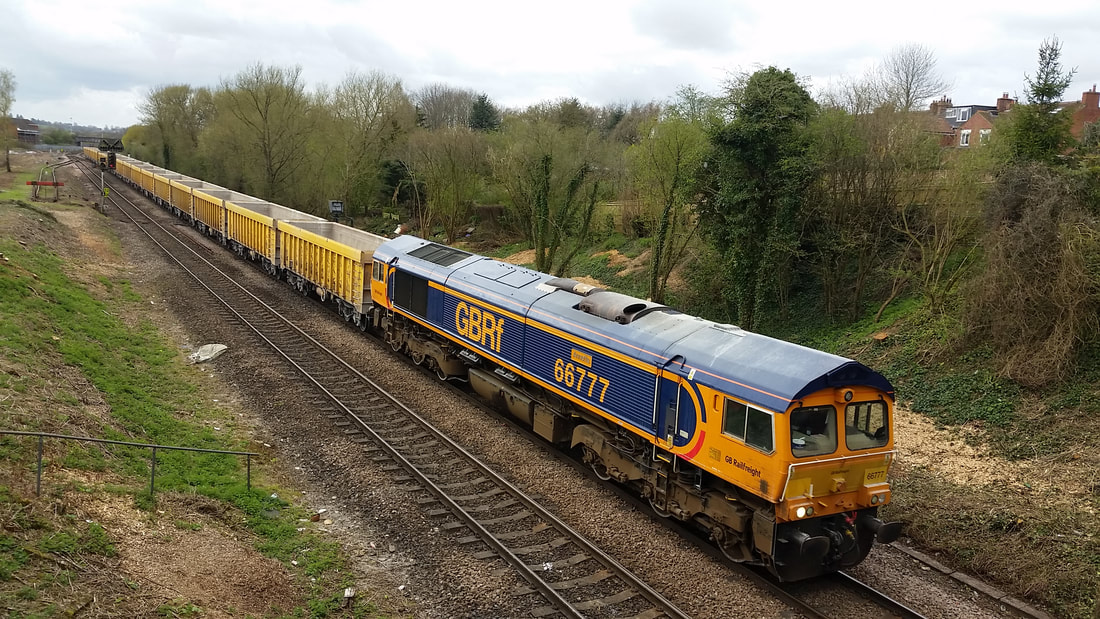
GBRF's 66777 'Annette' departing Westbury on 6M40 1156 Westbury-Stud Farm empty ballast boxes today, 16th April 2018. The area between Hawkeridge Junction and Westbury North Junction has recently been cleared of vegetation giving views that have not been possible since the 1960s. How long before nature again reclaims though?
Copyright Guy Vincent. Many thanks Guy.
Remember the stone trains to and from Wootten Basset.
Report sightings at Hawkeridge on the 5th June 2018 Guy Vincent
Today around lunchtime I happened by chance to get news of an extremely rare and unusual working through Westbury and was able to get out for an hour to record it. Rail Operations Group 47813, formerly owned by Direct Rail Services and named 'Solent', also once operated by Great Western Trains for many years and named 'SS Great Britain', came through at 1420 with a rake of JSA wagons running as 6O86 0900 Long Marston-Eastleigh Arlington. These wagons were converted in 1996 by Marcroft at Stoke-on-Trent for use between Shotton and Llanwern, before that they were iron-ore bogie tippler wagons used on Ravenscraig steelworks traffic. The '47' may have once been a common sight but the wagons were quite possibly making their debut here.
Shortly after that train had departed GBRF 66701 came through on 6M46 1218 Marchwood-Bicester MOD stores train which runs 'as required' via Westbury, Melksham and Oxford. Waiting on the 'down Trowbridge' for it to pass through Westbury North Junction was recently-arrived 'Turbo' 166214 on 2C18 1242 Gloucester-Frome.
Guy Vincent Many thanks Guy
Today around lunchtime I happened by chance to get news of an extremely rare and unusual working through Westbury and was able to get out for an hour to record it. Rail Operations Group 47813, formerly owned by Direct Rail Services and named 'Solent', also once operated by Great Western Trains for many years and named 'SS Great Britain', came through at 1420 with a rake of JSA wagons running as 6O86 0900 Long Marston-Eastleigh Arlington. These wagons were converted in 1996 by Marcroft at Stoke-on-Trent for use between Shotton and Llanwern, before that they were iron-ore bogie tippler wagons used on Ravenscraig steelworks traffic. The '47' may have once been a common sight but the wagons were quite possibly making their debut here.
Shortly after that train had departed GBRF 66701 came through on 6M46 1218 Marchwood-Bicester MOD stores train which runs 'as required' via Westbury, Melksham and Oxford. Waiting on the 'down Trowbridge' for it to pass through Westbury North Junction was recently-arrived 'Turbo' 166214 on 2C18 1242 Gloucester-Frome.
Guy Vincent Many thanks Guy
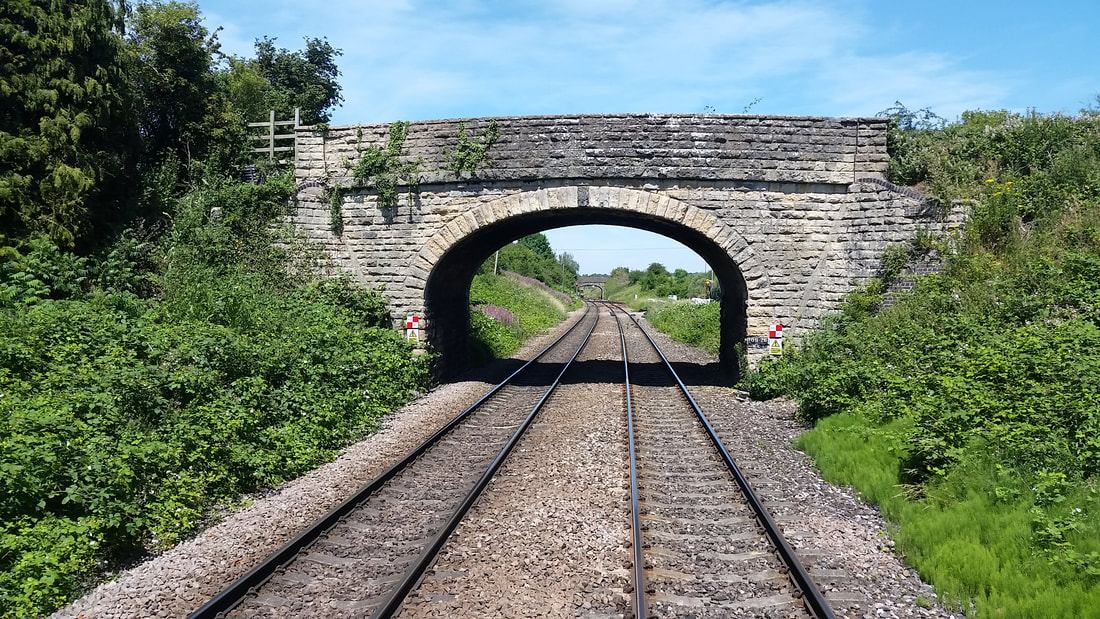
Hawkeridge Road overbridge looking north. Built between 1846-8 this bridge remains in almost as-built condition and follows the same pattern as the majority of overbridges built for the Wilts Somerset and Weymouth Railway between Thingley Junction and Frome. The bridge beyond is known as Shallow Wagon Lane overbridge and takes a bridleway path down to some fields. Both parapet walls were rebuilt in 1980-1.
Copyright Guy Vincent.
More on Hawkeridge Junction - Chris Bellett
Hi Keith,
Looking at the recent photographs of the track relaying work at Hawkeridge (near Westbury) reminded me of a visit I made to there in 1970 to record the signalling arrangements. I have attached some photographs for you.
Hawkeridge signalbox was opened on 14 July 1942 to control the new Loop Lines to Heywood Road Junction and a set of extensive War Department sidings (the latter being completed on 02 November 1943). The sidings didn’t last long as they were instructed to be removed by the War Department on 17 March 1949. Some of the connections, however, remained in situ until c1962. Hawkeridge signalbox was closed on 14 May 1984 and the area became controlled by Westbury Panel signalbox, as it is to this day.
Looking at the recent photographs of the track relaying work at Hawkeridge (near Westbury) reminded me of a visit I made to there in 1970 to record the signalling arrangements. I have attached some photographs for you.
Hawkeridge signalbox was opened on 14 July 1942 to control the new Loop Lines to Heywood Road Junction and a set of extensive War Department sidings (the latter being completed on 02 November 1943). The sidings didn’t last long as they were instructed to be removed by the War Department on 17 March 1949. Some of the connections, however, remained in situ until c1962. Hawkeridge signalbox was closed on 14 May 1984 and the area became controlled by Westbury Panel signalbox, as it is to this day.
The front of the signalbox. Note the Asbestos panelled roof and signalman’s Privy to the left. The two bracket signals to the right were of the ‘all steel’ type first introduced by the GWR in early 1942, so this was one of the first such installations.
Looking South towards the Junction and signalbox. Loop Lines to Heywood Road Junction to the left and Main Lines to Westbury North to the right.
Looking North towards the Junction and signalbox. Main Lines to Westbury North to the left and Loop Lines to Heywood Road Junction to the right. DMU just coming into view on the left on a Bristol bound service.
Looking North away from the signalbox towards Trowbridge. The War Department sidings were located on the barren land to the left.
At the time of my photographs Hawkeridge signalbox was normally switched out of circuit (closed) and the Loop Lines not regularly used. In the last photograph there used to be a Westbury North distant signal No.1 under the higher signal arm but this was removed at some date yet to be determined and the stop signal arm became dual controlled (slotted in signalling terms) by Westbury North as its Outer Home signal No.1. At the foot of the right hand mast (left hand as we look at the photograph) you can see that the arm balance weight for Hawkeridge signalbox No.36 is in the OFF (cleared or raised) position, but that for Westbury North signal No.1 is in the ON (danger or normal) position and thus the signal arm itself is in the ON (danger) position. It therefore required both signalboxes to clear the signal to OFF. The distant signal on the left hand mast (right hand as we look at the photograph) was Heywood Road Junction Up Loop Line distant signal No.6 and was operated by an electric motor which is the black box that can be seen just above the signal platform.
Hope that bit of lost history is of interest.
Kind Regards,
Chris Bellett
Retired S&T Engineer
At the time of my photographs Hawkeridge signalbox was normally switched out of circuit (closed) and the Loop Lines not regularly used. In the last photograph there used to be a Westbury North distant signal No.1 under the higher signal arm but this was removed at some date yet to be determined and the stop signal arm became dual controlled (slotted in signalling terms) by Westbury North as its Outer Home signal No.1. At the foot of the right hand mast (left hand as we look at the photograph) you can see that the arm balance weight for Hawkeridge signalbox No.36 is in the OFF (cleared or raised) position, but that for Westbury North signal No.1 is in the ON (danger or normal) position and thus the signal arm itself is in the ON (danger) position. It therefore required both signalboxes to clear the signal to OFF. The distant signal on the left hand mast (right hand as we look at the photograph) was Heywood Road Junction Up Loop Line distant signal No.6 and was operated by an electric motor which is the black box that can be seen just above the signal platform.
Hope that bit of lost history is of interest.
Kind Regards,
Chris Bellett
Retired S&T Engineer
Many thanks Chris
Further to Chris Bellett's article the following from Guy Vincent.
Hawkeridge Loop Track & Signalling
A photo of the 'other' end of the Hawkeridge loop line at Westbury with DB Cargo 66113 waiting at the signal protecting Westbury East Loop Junction on 6M15 0707 Tytherington-Calvert. This was taken from the window of a class 800 approaching Westbury this morning (23rd) and shows the newly laid track on both lines that will now see increased use as demand for aggregates in the south Midlands and South East continues to grow. Also an older shot of the junction from April 2013 looking towards Westbury.
Regarding Chris Bellett's photos of Hawkeridge taken in 1970. The 'missing' distant signal on the right-hand post for trains running towards Westbury was later reinstated, possibly around 1978 when the south end of the station was resignalled with MAS. I remember it having a large white 'out of use' cross placed upon it for some time prior to being brought into service. (Photo by Bob Taylor dated 29.04.1984, train signalled for the loop line). The crossover seen here was removed along with the semaphores just two weeks later when the area was transferred to Westbury Panel box. In later years the telegraph poles (right) ran from Hawkeridge 'box as far as Trowbridge station from where cables took over as far as Bradford Junction signal box. These were replaced by the white concrete MAS ducting (left) and removed later in 1984.
Guy Vincent
A photo of the 'other' end of the Hawkeridge loop line at Westbury with DB Cargo 66113 waiting at the signal protecting Westbury East Loop Junction on 6M15 0707 Tytherington-Calvert. This was taken from the window of a class 800 approaching Westbury this morning (23rd) and shows the newly laid track on both lines that will now see increased use as demand for aggregates in the south Midlands and South East continues to grow. Also an older shot of the junction from April 2013 looking towards Westbury.
Regarding Chris Bellett's photos of Hawkeridge taken in 1970. The 'missing' distant signal on the right-hand post for trains running towards Westbury was later reinstated, possibly around 1978 when the south end of the station was resignalled with MAS. I remember it having a large white 'out of use' cross placed upon it for some time prior to being brought into service. (Photo by Bob Taylor dated 29.04.1984, train signalled for the loop line). The crossover seen here was removed along with the semaphores just two weeks later when the area was transferred to Westbury Panel box. In later years the telegraph poles (right) ran from Hawkeridge 'box as far as Trowbridge station from where cables took over as far as Bradford Junction signal box. These were replaced by the white concrete MAS ducting (left) and removed later in 1984.
Guy Vincent
In response to Guy Vincents comment on my 1970 photographs of Hawkeridge concerning the distant signal for Westbury North. Guy is indeed correct that the distant arm was 'reinstated' as part of the scheme to close Westbury South signalbox and control that area from a mini-panel in Westbury North signalbox (renamed plain Westbury). The 'new' distant arm was controlled by an electric motor. The work was shown in WR Signalling Notice 31/W/2746 and was commissioned on 09/10/1978.
From the notice:
"An additiional distant arm will be provided below the Down Main Home signal at Hawkeridge acting as the Down Trowbridge distant signal to signals W102 and W302, the lower arm beneath the Westbury Down Home becoming the Intermediate distant"
It should also be noted that the Hawkeridge Down Main Home signal was also slotted (dual controlled) by Westbury (North as was) and so that signalbox controlled both the Home signal arm and Lower Distant signal arm on the same post. That was quite a rare, but not unique arrangement.
Kind Regards,
Chris Bellett
Retired S&T Engineer
From the notice:
"An additiional distant arm will be provided below the Down Main Home signal at Hawkeridge acting as the Down Trowbridge distant signal to signals W102 and W302, the lower arm beneath the Westbury Down Home becoming the Intermediate distant"
It should also be noted that the Hawkeridge Down Main Home signal was also slotted (dual controlled) by Westbury (North as was) and so that signalbox controlled both the Home signal arm and Lower Distant signal arm on the same post. That was quite a rare, but not unique arrangement.
Kind Regards,
Chris Bellett
Retired S&T Engineer
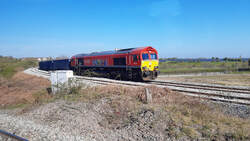 Westbury East Loop Junction (Up) 66113 6M15 07.07 Tytherington-Calvert 23rd April 2021. Copyright Guy Vincent
Westbury East Loop Junction (Up) 66113 6M15 07.07 Tytherington-Calvert 23rd April 2021. Copyright Guy Vincent
Many thanks Guy.
Westbury Twenty eight miles from BTM
